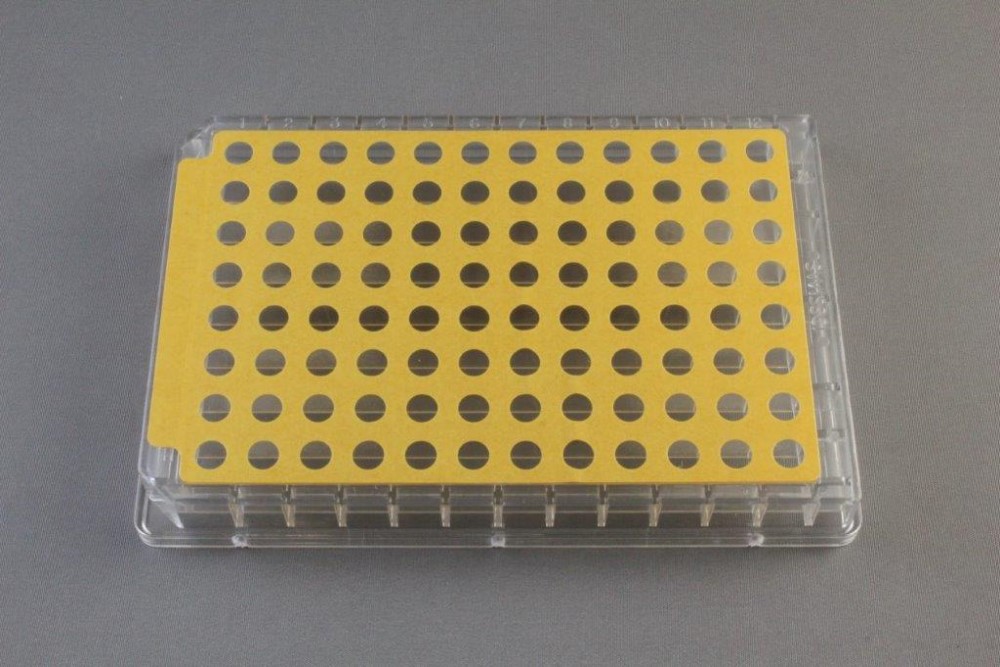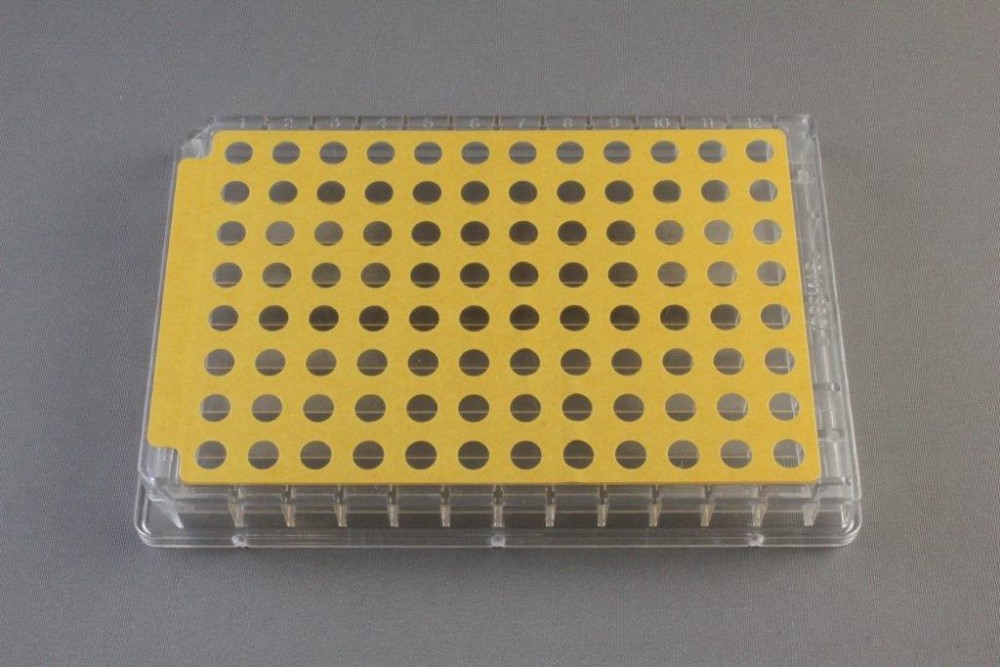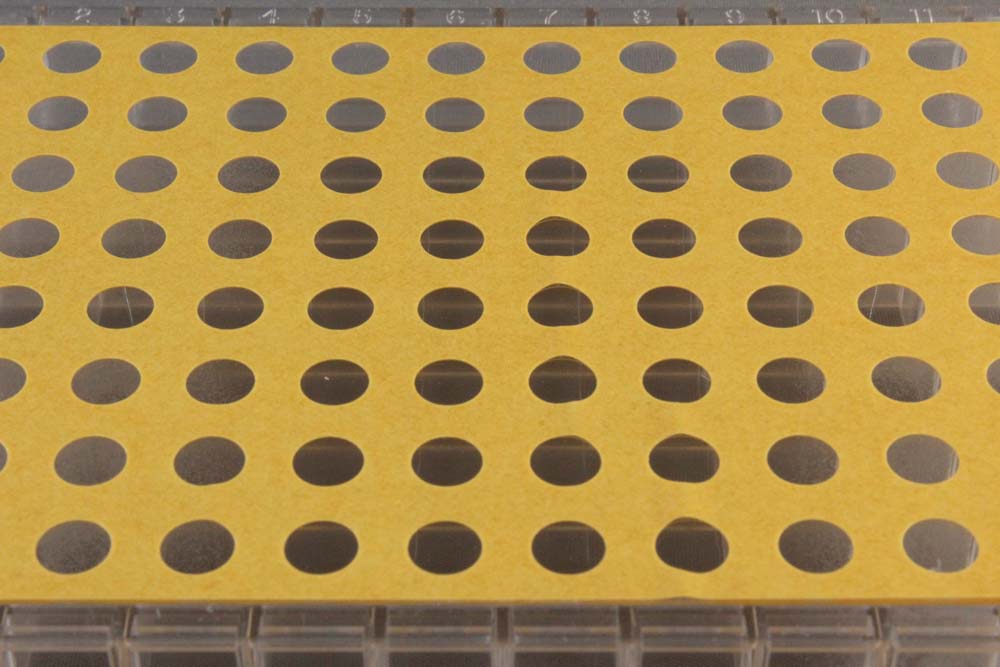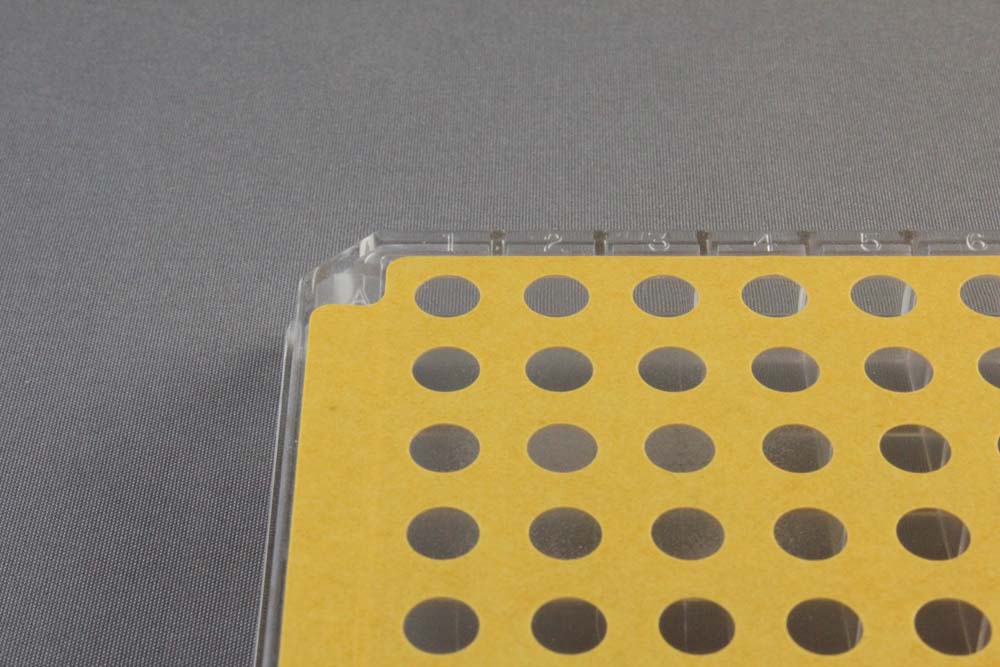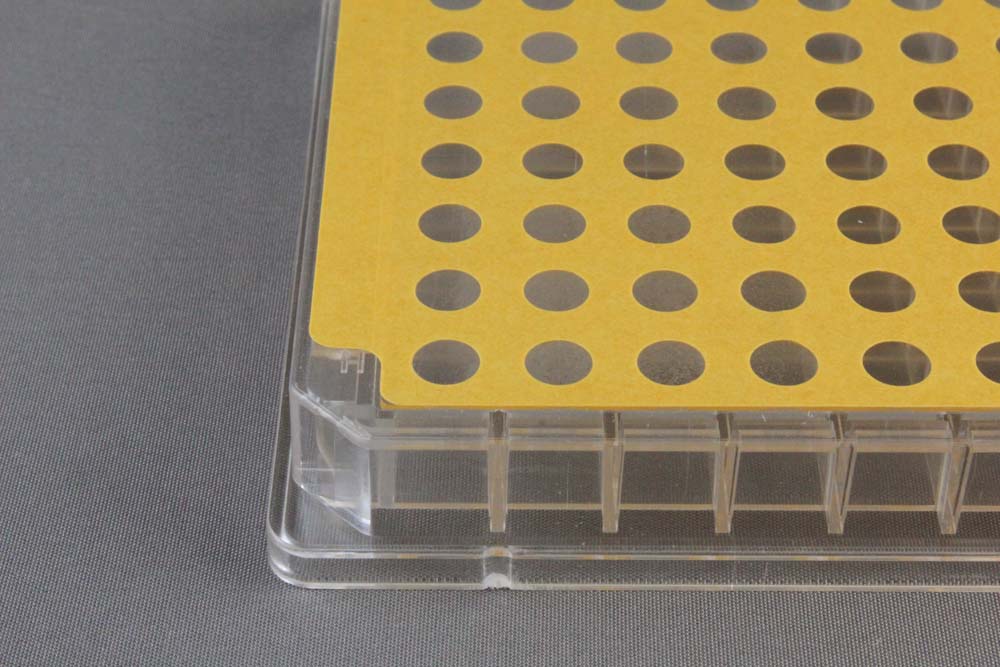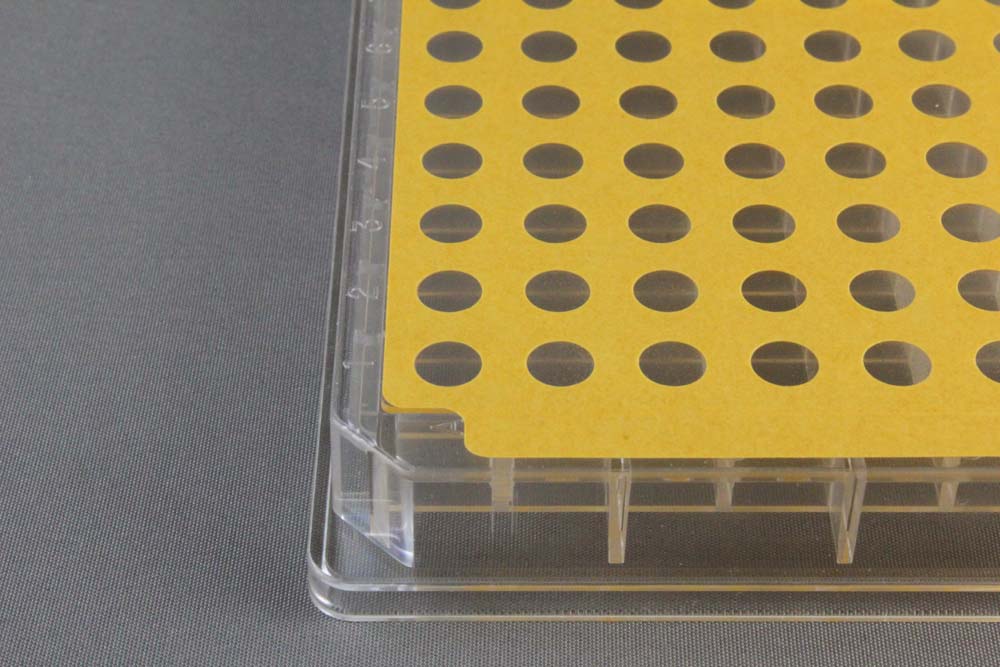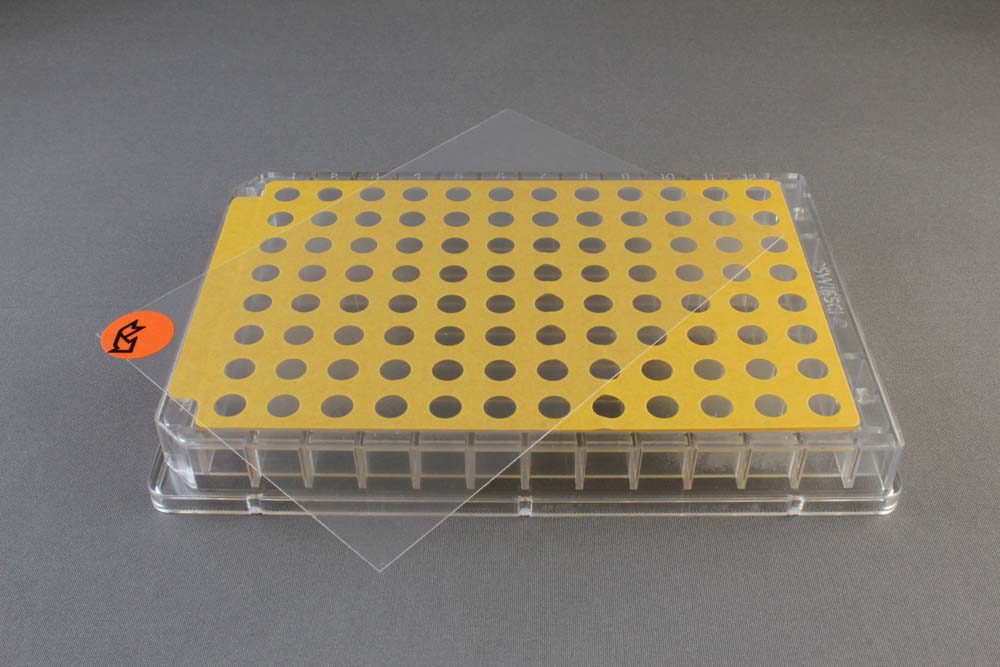- 型号 6890-2507
- 品牌 GE whatman沃特曼
- 【简单介绍】
品牌 其他品牌 沃特曼GD/X 25mm玻璃微纤维针头式过滤器
GD/X针头式滤器为高颗粒含量样品的过滤提供*方案
·溶解度测试
·含量均一性
·浓度分析
·常规样品准备
·食品分析沃特曼GD/X 25mm玻璃微纤维针头式过滤器 6890-2507
含GF/F 的WHATMAN GD/X?针头式滤器实物照GD/X?专为高粒子含量的样品而设计,无色聚丙烯外壳,预滤层由GMF 150(密度梯度)和GF/F玻璃微纤维介质组成,预滤层消除了样品污染物,即使是难于过滤的样品也有较小的操作压力。GD/X针头式滤器的过滤量是普通针头式滤器的3-7倍。
GMF 150和GF/F由*硼硅酸盐玻璃微纤维制成,创新的、梯度密度的GMF 150介质的zui上层为粗糙网格状,而底部光滑,可保留zui小1.0μm的颗粒。GF/F滤层可保留zui小0.7μm颗粒,预滤层下面是终滤膜。
GD/X具有更大负载量及更快的速度,而不会像常规滤器过滤阻塞时产生反压。
特征 25 mm GD/X
·滤器直径有13和25mm两种
·13mm滤器可过滤zui多10ml样品,25mm的可过滤10ml以上样品(可过滤的样品量还依赖于待滤样品特征)
·有无菌包装
·无色聚丙烯外壳
·由Whatman GMF 150(密度梯度)和GF/F玻璃微纤维组成的特有预滤层优点
·去除样品污染物
·即使是很难过滤的样品,也不需要很大操作压力
·是普通滤器过滤量的3-7倍应用
GD/X针头式滤器为高颗粒含量样品的过滤提供*方案
·溶解度测试
·含量均一性
·浓度分析
·常规样品准备
·食品分析
·环境样品
·混合物分析沃特曼GD/X 25mm玻璃微纤维针头式过滤器 6890-2507 订货信息:
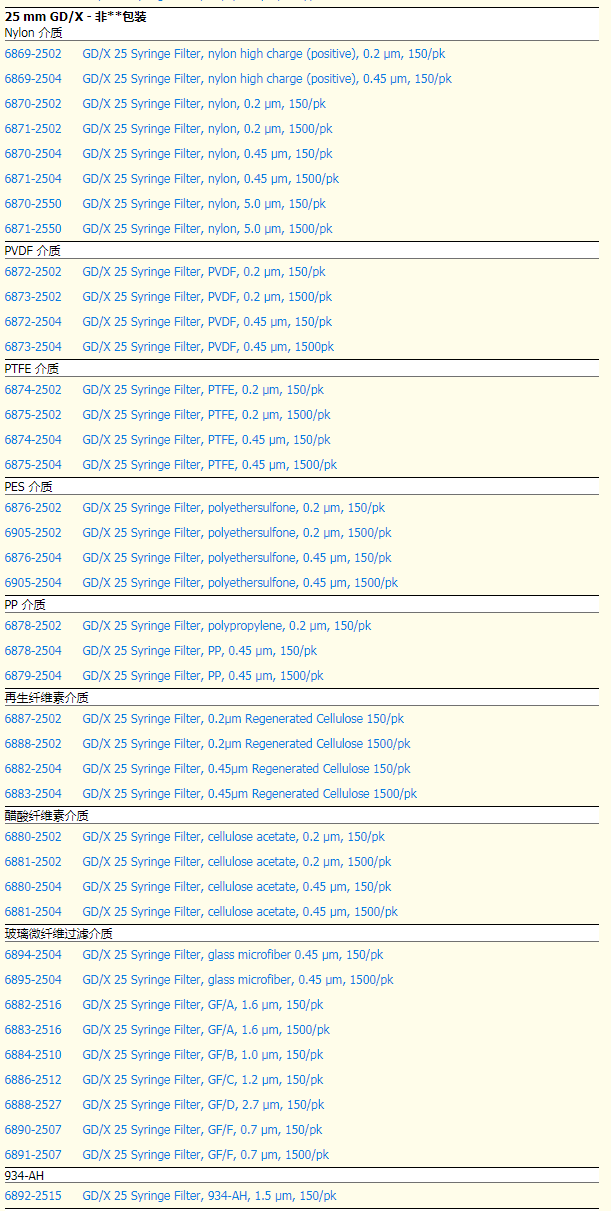
标签归档:amp
110611-Whatman细胞培养径迹蚀刻膜2.0um聚碳酸酯膜
- 型号 110611
- 品牌 GE whatman沃特曼
- 【简单介绍】
Whatman细胞培养径迹蚀刻膜2.0um聚碳酸酯膜
·良好的耐化学性和热稳定性,适用于大多数样品
·低灰分、低皮重
·膜表面光滑而平整,便于对截留物粒子进行观察
·可提供黑色膜,用于荧光和其它显微镜法,背景反差大基本参数:
孔径:2um
直径:25mm
包装:100片/盒
现货供应中!
WHATMAN沃特曼PC膜110611(孔径2um)
应用*
·荧光显微镜
·生物分析
·环境分析
·寄生生物学
·细胞培养
·空气分析
·EPA检验
·水体微生物学
·燃料检验*特性*
·不吸附蛋白和提取物,对样品无污染
·良好的耐化学性和热稳定性,适用于大多数样品
·低灰分、低皮重
·膜表面光滑而平整,便于对截留物粒子进行观察
·可提供黑色膜,用于荧光和其它显微镜法,背景反差大Whatman细胞培养径迹蚀刻膜2.0um聚碳酸酯膜 110611
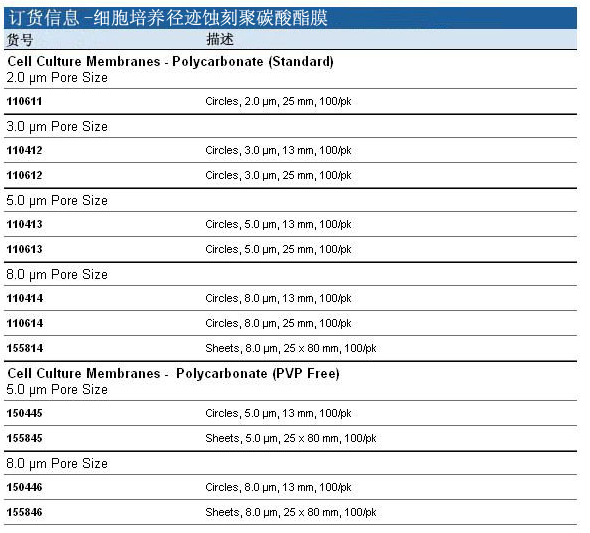
110608-沃特曼WHATMAN Nuclepore径迹蚀刻滤膜
- 型号 110608
- 品牌 GE whatman沃特曼
- 【简单介绍】
沃特曼WHATMAN Nuclepore径迹蚀刻滤膜 110608,
·低灰份和皮重
·表面光滑平展,便于观测
·低蛋白吸附力,低水平反吸附,确保样品不被污染
·高化学抗性和热稳定性,适合多样样品直径:25mm
包装规格:100片/盒
孔径:0.6um英国Whatman Nuclepore™经济蚀刻聚碳酸酯膜,由高品质聚碳酸酯薄膜制成,孔径精确、流速快,的抗化学、抗热性能。膜表面光滑平整,几乎没有反吸附。不溶于大多数有机溶剂(lv仿、二氯甲烷、N-甲基-2-吡喏烷酮除外)或浸出,不吸附蛋白质,确保样品的洁净度。
NucleporeTM黑色径迹蚀刻膜
用于落射荧光显微镜分析
NucleporeTM黑色径迹蚀刻膜极适合落射荧光显微镜分析,黑色膜极大降低了背景荧光,增强微生物和颗粒物的可见性。NucleporeTM黑色径迹蚀刻膜与落射荧光显微镜技术结合,30分钟内快速计数存活或不存活的生物或颗粒物,而传统方法需培养24小时以上,而该技术可以快速且直接地进行微生物的计数。
特点:
·低蛋白吸附力,低水平反吸附,确保样品不被污染
·高化学抗性和热稳定性,适合多样样品
·低灰份和皮重
·表面光滑平展,便于观测
应用:
·荧光电子显微镜
·环境分析
·细胞生物学
·EPA检测
·燃料测试
·生物分析
·寄生虫学
·空气分析
·水生微生物
沃特曼WHATMAN Nuclepore径迹蚀刻滤膜 110608
订购信息:110608 孔径0.6um直径25mm 材质:PC
110613 孔径5um直径25mm 材质:PC
110615 孔径10um直径25mm 材质:PC
A100A025A-东洋1um白色无方格混合纤维素酯过滤膜
- 型号 A100A025A
- 品牌 ADVANTEC东洋
- 【简单介绍】
东洋1um白色无方格混合纤维素酯过滤膜 A100A025A
·高蛋白质***性,可使用预处理作为预防。
·高度多孔结构提供较大流速。
·高纯度:没有表面活性剂。Advantec混合纤维素滤膜
成分:混合纤维素脂也称为硝化纤维
·高度多孔结构提供较大流速。
·高蛋白质***性,可使用预处理作为预防。
·高纯度:没有表面活性剂。
·可高温高压消毒:可承受高温高压温度zui高130℃不会影响起泡点,流速或微生物的过滤性能。
·快速湿润时间:使用1%亚甲基蓝湿润47mm直径滤膜,时间小于<3秒。
用途
·标准滤膜可使用在不同实验室应用,包括生物液体过滤消毒,微生物分析,污染分析和空气监控。
·可以透明化观看收集的颗粒—使用兼容液体(浸油,***)或选择透光滤膜用于“热障碍”***蒸汽法。
·有方格滤膜可量化微生物生长。
·可选没有消毒或经***消毒两种滤膜。
东洋1um白色无方格混合纤维素酯过滤膜 A100A025A
产品型号 详细信息
A100A013A ADVANTEC混合纤维素酯膜:
没有消毒,
白色没有方格,
孔径:1.00μm,
直径:13mm,
100片包装。
A100A025A ADVANTEC混合纤维素酯膜:
没有消毒,
白色没有方格,
孔径:1.00μm,
直径:25mm,
100片包装。
A100A037A ADVANTEC混合纤维素酯膜:
没有消毒,
白色没有方格,
孔径:1.00μm,
直径:37mm,
100片包装。
A100A047A ADVANTEC混合纤维素酯膜:
没有消毒,
白色没有方格,
孔径:1.00μm,
直径:47mm,
100片包装。
OA300C12-美国PALL 300K Minimate切向流超滤膜包
- 型号 OA300C12
- 品牌 PALL颇尔
- 【简单介绍】
美国PALL 300K Minimate切向流超滤膜包 OA300C12
应用:·蛋白质、肽、或核酸(DNA、RNA、寡核苷酸)的浓缩和脱盐;
·从澄清后的细胞培养介质中回收抗体或重组蛋白质;
·处理对于金属敏感的酶和分子;
·分离不同尺寸的生物分子;
特点:
·高效—在同一系统中进行浓缩和洗滤(脱盐或缓冲液置换)处理,仅需简单的安装。
·高浓缩系数—由于装置的低残留体积,一步操作即可获得高浓缩系数;处理样品体积数高达1L甚至更多,高效将其浓缩至5mL之低。
·即插即用—Minimate切向流超滤膜包中包含所有配件和管路,以简化过滤安装设定,此通用装置可与所有类型的实验室正压泵配合使用。
·针对非苛刻应用的高性价比设计—Minimate切向流超滤膜包为塑料结构,Omega聚醚砜超滤滤膜具有良好的化学相容性,方便清洗与再次应用。
·工艺可放大—可将数只Minimate切向流超滤膜包并联连接,以获得增加的滤膜面积。Minimate切向流超滤膜包,对比Pall公司用于中试(或生产)规模的较大Centramate与Centrasette系统,其中的流体通路长度和结构材料完全相同。对流程进行工艺放大时,处理性能可以预测,将大大地节约认证时间。
·高回收率—*化的流体通路设计,连同低蛋白质吸附的Omega滤膜,将非特异性结合程度降至低。
·一次性使用—此装置成本低廉,可用于单批样本或单次处理,以节约清洗和验证时间。
·信心保证—在生产过程中,每只制药级Minimate超滤膜包均通过99%完整性测试,以确保其可靠性能。在要求苛刻的应用中,用户在*使用后,可复验其完整性。每只超滤膜包均附带有质量保证书。
应用:
·蛋白质、肽、或核酸(DNA、RNA、寡核苷酸)的浓缩和脱盐;
·从澄清后的细胞培养介质中回收抗体或重组蛋白质;
·处理对于金属敏感的酶和分子;
·分离不同尺寸的生物分子;
·浓缩病毒或基因治疗载体;
·用于制备层析处理之前、之中、之后步骤的样品;
·在凝胶过滤后浓缩样品;
·去除水、缓冲液、介质溶液中的致热源。
规格
滤材:Omega滤膜(改性聚醚砜)
壳体:聚丙烯,玻璃纤维加固筛网
滤膜板/滤出液通路:聚乙烯
内部垫圈:乙烯丙烯弹性体
有效过滤面积:50cm2(0.05ft2)
外部尺寸:20cm×3.8cm×1.8cm
流速建议值:30-40mL/min(0.6-0.8L/min/ft2)
产物残存体积(进料/回流):大约为1.6mL
工作温度范围:5℃至50℃
工作压力大值:4bar
PH值范围:1-14
空气完整性测试值:≤7/mL/min,在0.75巴(70千帕斯卡,10磅/平方英寸)下
美国PALL 300K Minimate切向流超滤膜包 OA300C12
订购信息
产品编号 说明 包装
OAD65C12 650D 1/pkg
OA001C12 1K 1/pkg
OA003C12 3K 1/pkg
OA005C12 5K 1/pkg
OA010C12 10K 1/pkg
OA030C12 30K 1/pkg
OA050C12 50K 1/pkg
OA070C12 70K 1/pkg
OA100C12 100K 1/pkg
OA300C12 300K 1/pkg
OA500C12 500K 1/pkg
OA990C12 1000K 1/pkg
MAP010C38-PALL颇尔 离心浓缩管
- 型号 MAP010C38
- 品牌 PALL颇尔
- 【简单介绍】
PALL颇尔 离心浓缩管 MAP010C38
· 可迅速把20ml样品浓缩到0.5ml。· 回收率高,通常可达90%以上。
· Pall Omega膜和聚丙烯外壳的蛋白质结合率低,能把由非特异性结合引起的损失降低到zui低。
· 多功能的Pall Omega膜可用于各种MWCO中。
· 以颜色编码,易于鉴别。
PALL颇尔 离心浓缩管 MAP010C38
说明
· 可迅速把20ml样品浓缩到0.5ml。
· 回收率高,通常可达90%以上。
· Pall Omega膜和聚丙烯外壳的蛋白质结合率低,能把由非特异性结合引起的损失降低到zui低。
· 多功能的Pall Omega膜可用于各种MWCO中。
· 以颜色编码,易于鉴别。
Pall 颇尔 Macrosep Advance离心浓缩管
应用
· 对蛋白样品进行浓缩和脱盐
· 对层析后的样品或梯度洗脱后的样品进行缓冲液的置换和脱盐
· 从细胞培养上清液或者裂解液中回收生物分子
· 从水溶液中去除颗粒
技术规格
制造材料
滤才: Omega (低蛋白吸附改性的聚醚砜) 和Supor膜(polyethersulfone) 样品池, 滤液接收器, 和盖子:聚丙烯
液板: 聚乙烯
有效过滤面积:7.2 cm2
尺寸:直径:50 mm (1.9 in.),长度:12.0 cm (4.7 in.)
容量:zui大样品体积:20 mL,zui终浓缩体积:根据使用的转头而定,zui少可达450?L。滤液槽体积:22 mL,残留体积(膜/支撑物):80 ?L
操作温度范围:0 – 40 °C (32 – 104 °F)
pH范围:1-14
zui大离心力:5,000 x g (超滤),14,000 x g (微滤)
离心:适合使用标准的50 mL的管子
消毒情况:未灭菌。在使用前用70%的乙醇进行过滤,已进行消毒。性能
转头的选择决定zui终的浓缩液体积
转角 残留体积
吊桶式转头 450?L
45°固定角 1.2-1.5mL
34°固定角 1.5 mL
Pall 颇尔 Macrosep Advance离心浓缩管
PALL颇尔 离心浓缩管 MAP010C38
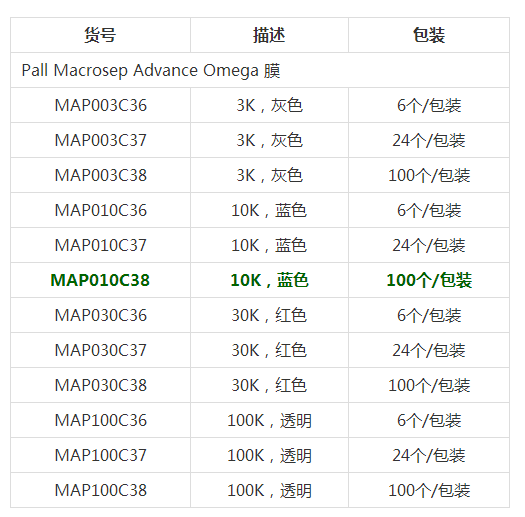
日本同仁化学Hampton蛋白结晶试剂盒LCP Lipidic Cubic Phase Screening- DOJINDO
上海金畔生物科技有限公司代理日本同仁化学 DOJINDO代理商全线产品,欢迎访问官网了解更多信息
上海金畔生物代理Hampton research品牌蛋白结晶试剂耗材工具等,我们将竭诚为您服务,欢迎访问Hampton research官网或者咨询我们获取更多相关Hampton research品牌产品信息。Products > 96 Well Crystallization Plates > Swissci > LCP Lipidic Cubic Phase Screening
LCP Lipidic Cubic Phase Screening
Applications
- Lipidic cubic phase crystallization
Features
- UVP cover film (UV compatible)
- No cross contamination
- Membrane protein crystallization
- 6 mm diameter drop well area
- 0.1 mm (100 μm) deep drop well when LCP plate is sealed
- Maximum drop volume is 1.6 microliters per well
Description
The Lipidic Cubic Phase Crystallization (LCP) plate facilitates the automation and increased throughput of LCP crystallization set-ups. This novel system enables LCP screening to be performed accurately and with ease – using manual – or automated systems to complete the delivery of the solutions.
Working with innovative scientists Professor Gebhard Schertler and Pat Edwards from the MRC laboratory in Cambridge, Swissci AG developed a new system for setting up LCP screens.
The Swissci LCP plate ensures crystallography set-up is fast, cost effective and robotically adaptable. In addition Ultra Violet light can be used with the glass / UVP polymers to visualize proteins without the light scattering associated with traditional polymeric solutions.
The LCP technique for crystallizing membrane proteins can be difficult and time-consuming to set up as it utilizes highly viscous lipid mesophases to reconstitute proteins. Swissci AG and MRC overcame these problems with the LCP plate. This product combines an easy to use sandwich system with dedicated coupling tapes and thin film UVP cover plates. It conforms to SBS standards and thus is perfect for modern automation applications where high throughput is required.
The Advantages of the LCP plate
• Ready to use the plate fits laboratory robotics and uses a Swissci unique polymer to ensure UV visualization is not compromised by polarization.
• Easy sealing with dry tabbed adhesive tape exposure and thin UVP cover film. Included in the kit is a plate leveling device to ensure the cover is perfectly adhered to the bottom LCP plate.
• No cross contamination and SBS standard.
• Unique low tack plate security allows for the sandwich plate to be removed from the base plate when required – in-situ x-ray data collection and structure determination is then enabled.
Here’s a description of the LCP plate from bottom to top. a) An SBS standard base plate frame support. b) 0.7 mm thick UVP plastic slide drop support containing all 96 drop wells with 0.1 mm thick layer of low tack sealant (no sealant in drop area). Flat, circular, 6 mm diameter drop wells to contain the LCP, sample and reagent. c) Removable brown/tan paper protects sealant until plate is ready to use. d) 0.1 mm thick UVP sealing film. e) Removable protective dust cover. The kit is completed with a Swissci plate leveling device.
To use the LCP plate, pipette LCP, sample and reagent into the 96 drop wells. Peel back and remove the brown/tan paper to expose the adhesive. Place the sealing film onto the LCP plate. Remove the protective film for viewing.
Maximum drop volume is 1.6 microliters per well.
CAT NO
HR3-186
NAME
DESCRIPTION
20 plate case
PRICE
$422.00
Temporarily Unavailable
More Available Soon!
Support Material(s)
 HR3-186 LCP Lipidic Cubic Phase Screen Kit User Guide
HR3-186 LCP Lipidic Cubic Phase Screen Kit User Guide 日本同仁化学Hampton蛋白结晶试剂盒Vial Clamp™ – Curved/HR4-671/HR4-672- DOJINDO
上海金畔生物科技有限公司代理日本同仁化学 DOJINDO代理商全线产品,欢迎访问官网了解更多信息
上海金畔生物代理Hampton research品牌蛋白结晶试剂耗材工具等,我们将竭诚为您服务,欢迎访问Hampton research官网或者咨询我们获取更多相关Hampton research品牌产品信息。
Products > Cryocrystallography > Cryo Tools > Vial Clamp™ – Curved
Vial Clamp™ – Curved
应用
- Vial support & manipulation
- 样品瓶支持和操作
特征
- Curved end tip
- Hemostat style closure
- 弯曲端头
止血式封口
描述
The Vial Clamp – Curved is a chrome plated, hemostat style tool. It has a tip shaped to hold the storage vial of all the CrystalCap Systems at an angle when the clamp is closed. The clamp can be locked using the hemostat style closure. The end of the clamp, where the vial is held, is curved at either a 45°/135° or 110°/ 70° angle. When the vial is placed in the clamp, the length of it is positioned to the clamp at either of those same angles. The overall length of each clamp is the same, 195 mm.
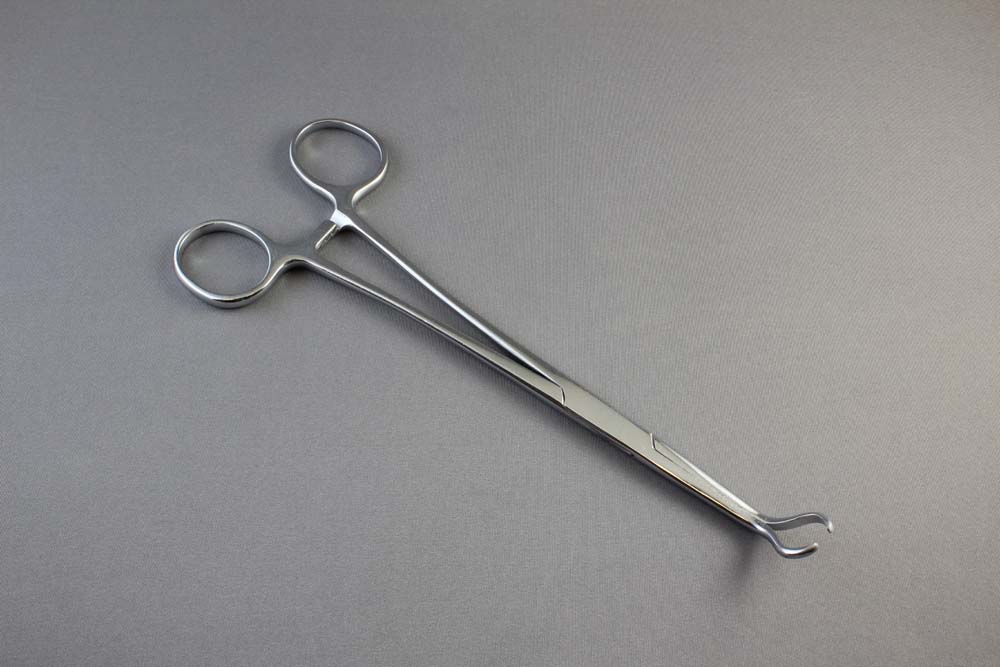

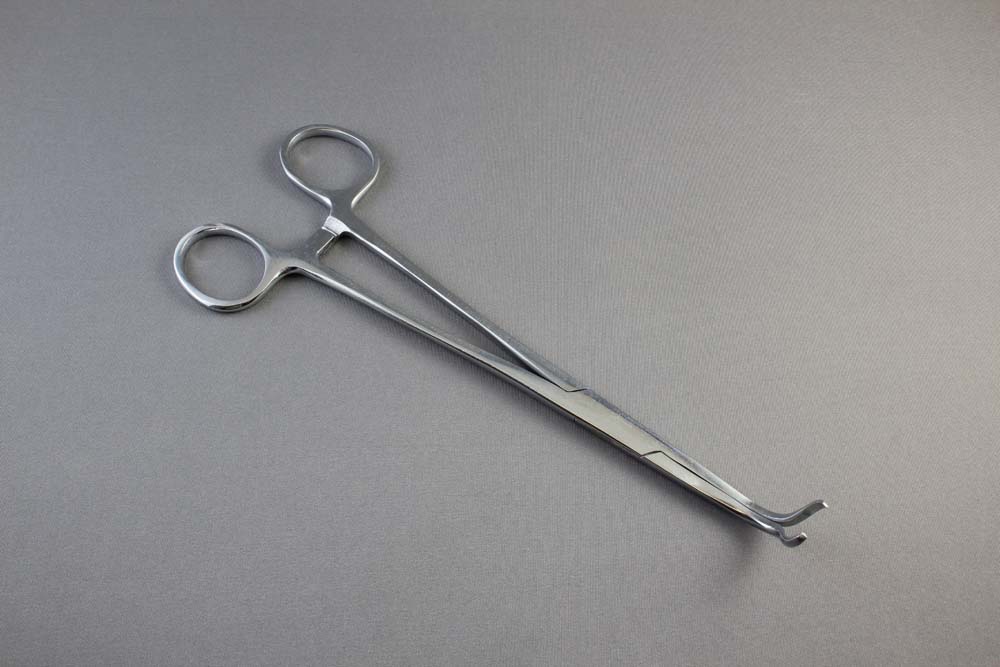
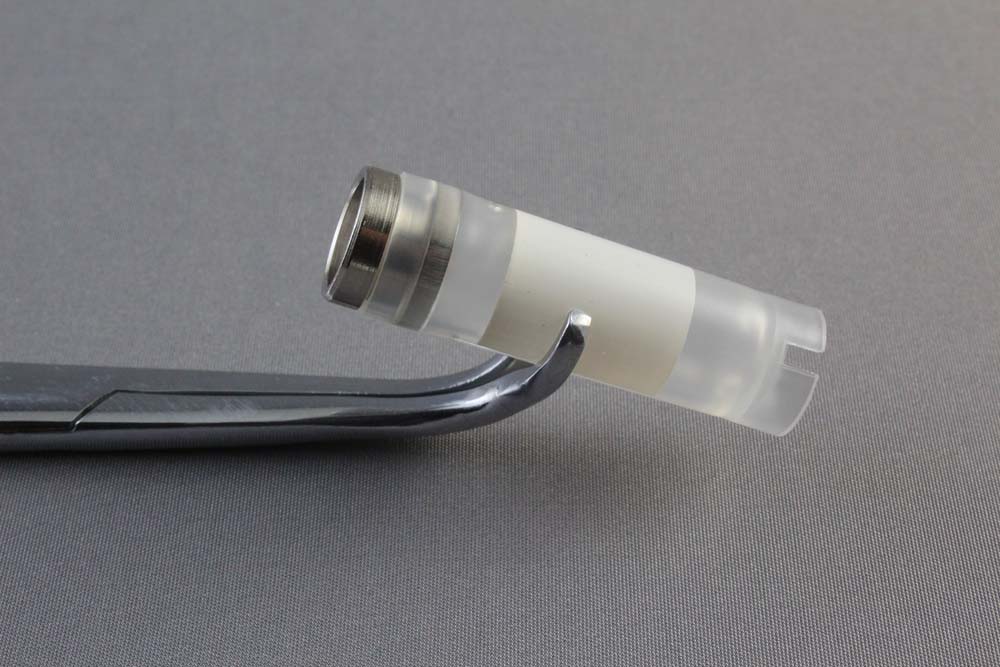
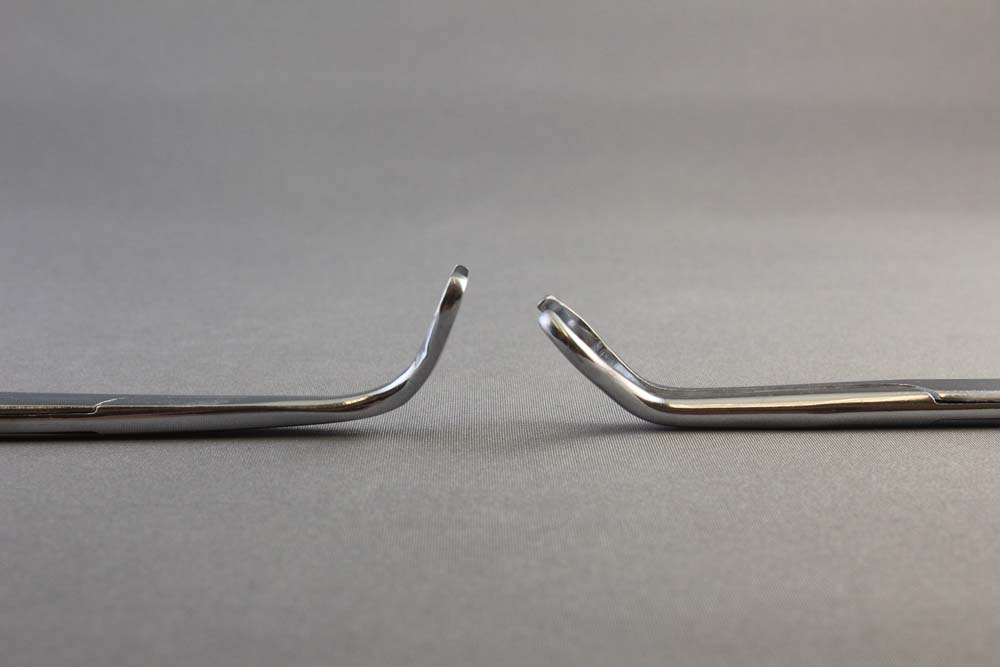
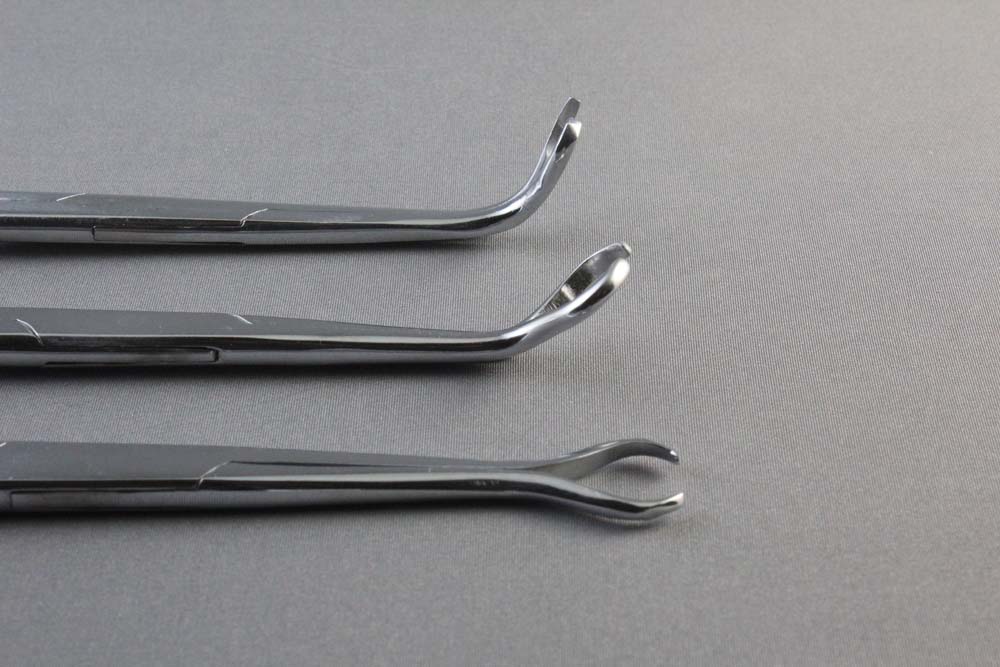
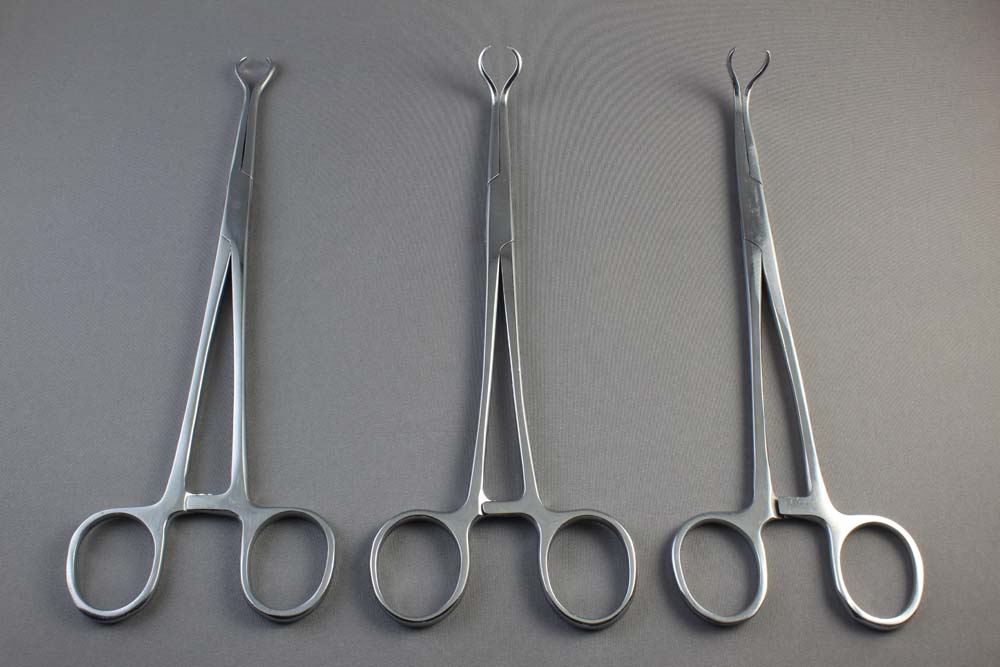
CAT NO
HR4-671
NAME
DESCRIPTION
each
PRICE
$67.00
CAT NO
HR4-672
NAME
DESCRIPTION
each
PRICE
$97.00
相关项目
- CrystalCap™
- CrystalCap™ SPINE HT
Insectagro FIVE™无血清/无蛋白培养基 美国Cellgro 货号:
名称:Insectagro FIVE™无血清/无蛋白培养基
品牌:美国Cellgro
订货号:
![]()
咨询此产品
产品介绍
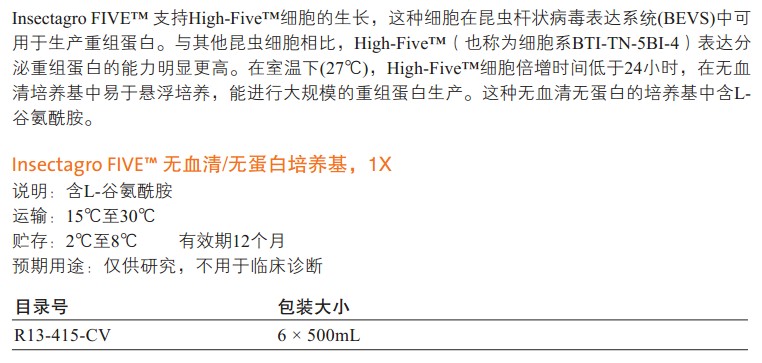
氟树脂过滤器光栅日本三博特sanplatec
确认材料的耐药性 >> 耐药性检索

 产品特征:
产品特征:※厚度:全部为3.0t ※孔径:全部为1.0Φ
※栅间隔:2.5 ※侧面:30°锥形
※可订做上述尺寸以外的产品,详情请咨询。
●特点
PTFE制,无需担心被药品腐蚀。
孔径1.0mmΦ,栅间隔2.5mm。精准度更高。※滤网请使用Φ47mm规格。(过滤网不包含在产品套装中。)
※光栅孔径为Φ1mm。
●特点
・最适合减压过滤。
・氟树脂制的过滤管, 耐药性优越。
・螺旋安装, 使用方便。
・只需更换过滤管就可改变容量。
・整个过滤管可拆开, 安装简单。
日本日水 CompactDry™菌落总数测试皿(TC) 06740 06741 现货
| 序号 | 简称 | 产品名称 | 时间 | 温度 | 货号 | 包装 |
| (枚/盒) | ||||||
| 1 | TC | CompactDry™菌落总数测试皿(TC) | 24-48h | 35±2℃ | 06740 | 40 |
| 54051100 | 100 | |||||
| 06741 | 240 | |||||
| 2 | TCR | CompactDry™菌落总数测试皿(TC) | 24h | 35±2℃ | 06539 | 40 |
| 54069100 | 100 | |||||
| 06540 | 240 | |||||
| 3 | CF | CompactDry™大肠菌群测试皿 (CF) | 24h | 35±2℃ | 06744 | 40 |
| 54053100 | 100 | |||||
| 06745 | 240 | |||||
| 4 | CF-L | CompactDry™大肠菌群测试皿 (CF-L) | 24h | 35±2℃ | 54065100 | 100 |
| 54065 | 240 | |||||
| 5 | EC | CompactDry™大肠菌群/大肠杆菌测试皿 (EC) | 24h | 35±2℃ | 06742 | 40 |
| 54052100 | 100 | |||||
| 06743 | 240 | |||||
| 6 | ETB | CompactDry™肠杆菌测试皿 (ETB) | 24h | 35±2℃ | 06535 | 40 |
| 54055100 | 100 | |||||
| 06536 | 240 | |||||
| 7 | YMR | CompactDry™快速霉菌酵母测试皿 (YMR) | 48-72h | 25±2℃ | 06777 | 40 |
| 54063100 | 100 | |||||
| 06778 | 240 | |||||
| 8 | X-SA | CompactDry™金黄色葡萄球菌测试皿 (X-SA) | 24h | 35±2℃ | 06729 | 40 |
| 54057100 | 100 | |||||
| 06730 | 240 | |||||
| 9 | SL | CompactDry™沙门氏菌测试皿 (SL) | 24h | 41-43℃ | 06732 | 40 |
| 54058100 | 100 | |||||
| 06733 | 240 | |||||
| 10 | BC | CompactDry™蜡样芽胞杆菌测试皿 (BC) | 24h | 35±2℃ | 06533 | 40 |
| 54068100 | 100 | |||||
| 06534 | 240 | |||||
| 11 | VP | CompactDry™副溶血性弧菌测试皿 (VP) | 20h | 35±2℃ | 06748 | 40 |
| 06749100 | 100 | |||||
| 06749 | 240 | |||||
| 12 | LM | CompactDry™单增李斯特菌测试皿 (LM) | 24-48h | 35±2℃ | 06531 | 40 |
| 54067100 | 100 | |||||
| 06532 | 240 | |||||
| 13 | PA | CompactDry™铜绿假单胞菌测试皿 (PA) | 24-48h | 35-37℃ | 54062100 | 100 |
| 14 | Swab | 1ml Swab涂抹棒BPW (Easy Wiping Kit BPW) | – | – | 06537 | 200支 |
| 15 | Swab | 1ml Swab涂抹棒PBS (Easy Wiping Kit PBS) | – | – | 06538 | 200支 |
Phos-tag™ 丙烯酰胺
Phos-tag™ 丙烯酰胺
Phos-tag™ Acrylamide
- 产品特性
- 相关资料
- Q&A
- 参考文献
Phos-tag™ Acrylamide
SDS-PAGE分离不同磷酸化水平的蛋白!
在不使用放射性同位素的情况下,利用Phos-tag™ SDS-PAGE即可分离不同条带中的磷酸化和非磷酸化蛋白。分离后的凝胶可用于Western blotting和质谱分析等后续实验。
Phos-tag™ SDS-PAGE操作简单,只需在常规SDS-PAGE胶中加入Phos-tag™ Acrylamide 和Mn2+或者Zn2+即可进行实验。在电泳过程中,磷酸化蛋白的磷酸基团与Phos-tag™中的二价金属离子相结合,降低其迁移速度,从而可区分磷酸化与非磷酸化蛋白。
◆原理
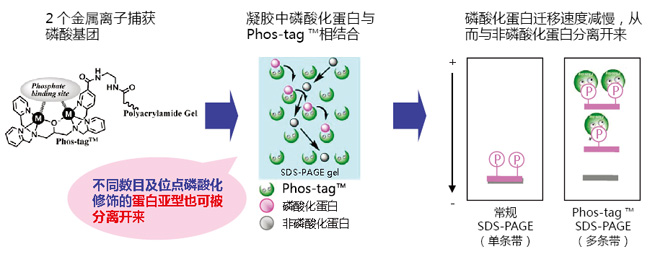
◆优点、特色
● 采用Phos-tag™ SDS-PAGE可轻松分离磷酸化蛋白
无任何放射性元素及化学标记!
● 可检测不同磷酸化水平的磷酸化蛋白
无需任何磷酸化抗体!
● 适用于内源性蛋白的磷酸化分析!
◆案例、应用
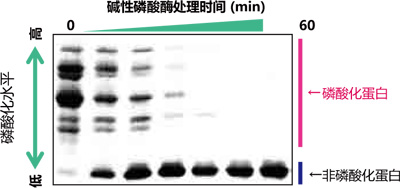
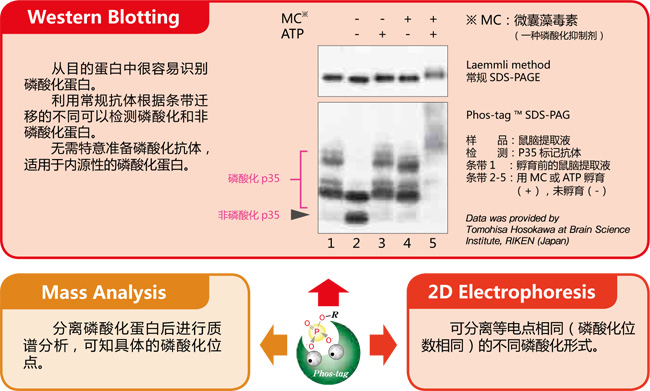
【使用Phos-tag™ SDS-PAGE的磷酸化/非磷酸化蛋白比较】
我推荐使用Phos-tag ™ ——东京大学研究院医学研究科 小川觉之
Phos-tag ™ 是专为研究磷酸化蛋白而新开发出来的试剂。此产品使用方便,不但可用于体外实验,还能定量分析体内蛋白的磷酸化水平。Phos-tag ™ SDS-PAGE 可用于常规电泳实验,无需购买特殊设备,性价比高。传统蛋白磷酸化的研究需要特异的磷酸化抗体、RI 等其它试剂,操作复杂,花费大,且放射性元素会有安全隐患,而Phos-tag ™ 的出现恰恰可以弥补这些缺点,为磷酸化蛋白研究提供新的方向。
磷酸化蛋白和非磷酸化蛋白利用Phos-tag ™ SDS-PAGE 的分离效果图
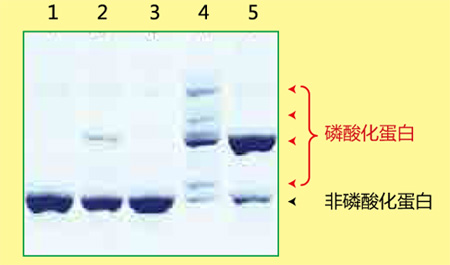
Lane 1 为非磷酸化蛋白,Lane 2-5 为磷酸化蛋白,各蛋白因磷酸化状态不同而条带迁移率也有所不同。
磷酸化/ 非磷酸化蛋白的数量比、磷酸化程度、磷酸化蛋白的丰度等都可根据条带迁移和条带浓度求得。
【资料提供】
日本东京大学研究生院医学系研究科
【二维电泳中的应用:分析hnRNP K 磷酸化异构体】
小鼠巨噬细胞J774.1 经LPS 刺激后,裂解细胞,经过免疫沉淀法分离得到hnRNP K。在二维电泳中,一维是IPG 胶,二维是Phos-tag ™ SDS-PAGE,可分离hnRNP K 的异构体。利用质谱仪,可以确认不同的点代表不同的亚型或修饰蛋白。
二维电泳
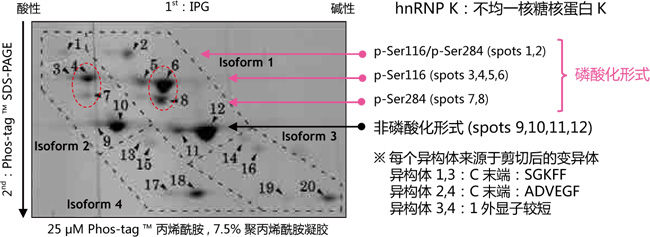
同一个等电点的位置上,不同位点发生磷酸化都可以被区分开来(例: spots 6 vs. 8 and spots 4 vs. 7)
【参考文献】
Characterization of multiple alternative forms of heterogeneous nuclear ribonucleoprotein K by phosphate-affinity electrophoresis. Y. Kimura, K. Nagata, N Suzuki, R. Yokoyama, Y. Yamanaka, H. Kitamura, H. Hirano, and O. Ohara, Proteomics , Nov 2010; 10(21): 3884-95.
【结果提供】
横滨市立大学 生命纳米系统科学研究科 生物体超分子系统科学专业 木村弥生(Dr. Y. Kimura)、平野久(Dr. H. Hirano)理化学研究所RCAI 小原收
【EGF 刺激前后MAPK 磷酸化水平的变化】
常规SDS-PAGE 和Phos-tagTM SDS-PAGE 后迚行克疫印迹实验分析EGF 刺激的A431 细胞中MAPK 磷酸化水平。

摘自Kinoshita-Kikuta, E. et al., Mol.Cell. Proteomics. (2007)6: 356.
操作视频,请点击:
样品处理(TCA沉淀):http://www.boppard.cn/resources/show/47.html
凝胶制备:http://www.boppard.cn/resources/show/48.html
已公开的验证蛋白列表,请点击
Phos-tag™ 系列
磷酸化蛋白新方法!
Phos-tag™是一种能与磷酸离子特异性结合的功能性分子。它可用于磷酸化蛋白的分离(Phos-tag™ Acrylamide)、Western Blot检测(Phos-tag™ Biotin)、蛋白纯化 (Phos-tag™Agarose)及质谱分析MALDI-TOF/MS (Phos-tag™ Mass Analytical Kit)。
◆Phos-tag™ 的基本结构
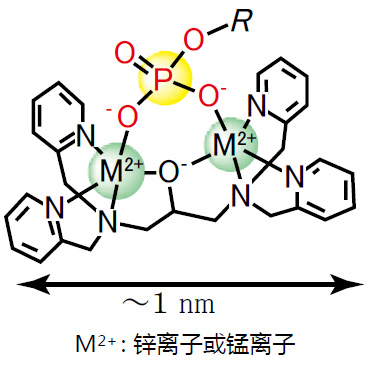
特点:
与-2价磷酸根离子的亲和性和选择性高于其它阴离子
在pH 5-8的生理环境下生成稳定的复合物
◆原理
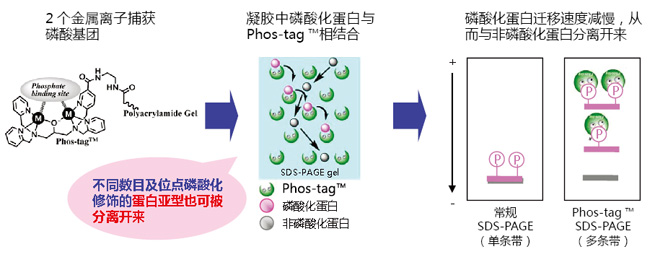
◆相关应用
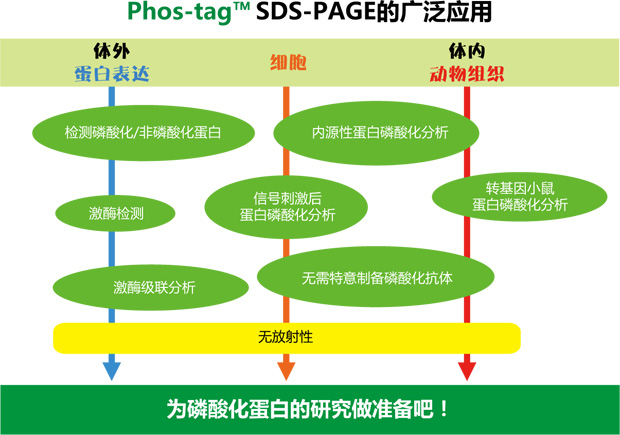
◆相关产品
|
产品名称 |
用 途 |
|
Phos-tag™ Acrylamide |
分离: SDS – PAGE 分离不同磷酸化水平的蛋白 |
|
SuperSep Phos-tag™ |
分离: 预制胶中含有50μM Phos-tag™ Acrylamide |
|
Phos-tag™ Biotin |
检测: 代替 Western Blot 检测中的磷酸化抗体 |
|
Phos-tag™ Agarose |
纯化: 通用柱层析,纯化磷酸化蛋白 |
|
Phos-tag™ Mass Analytical Kit |
分析: 用于质谱 MALDI-TOF/MS 分析,提高磷酸化分子的检测灵敏度 |
phos-tag™由日本广岛大学研究生院医齿药学综合研究科医药分子功能科学研究室开发。
更多产品信息,请点击:http://phos-tag.jp
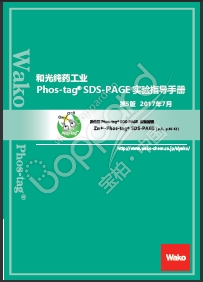
Phos-tag 第5版说明书
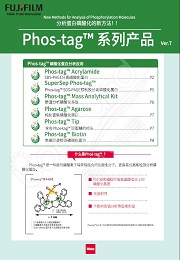
Phos-tag 系列产品 Ver.7 2
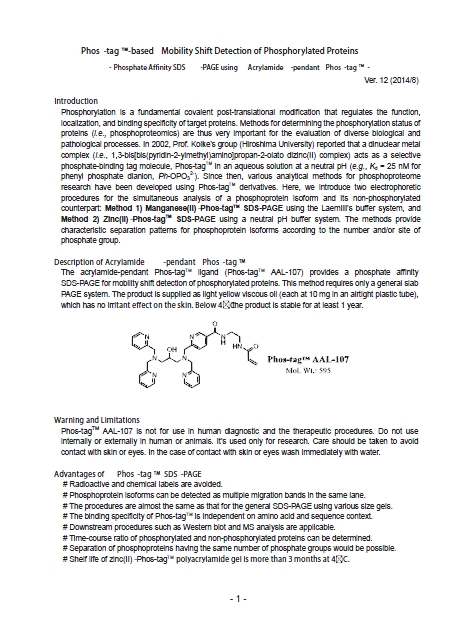
说明书
1. Phos-tag® Acrylamide的溶解
5mmmol/ Phos-tag® 液体 (3v/v% 甲醇):
1) 10mg Phos-tag® Acrylamide 里加入 0.1mL 甲醇
2) 使用枪头搅拌混合直至完全溶解。
3) 加3.2mL 蒸馏水, 用枪头混匀。
2-8℃避光保存。不适合零度以下保存。建议保存时间6个月。
注意:避免溶解过程出现白色悬浮颗粒。
2. α-Casein, from Bovine Milk, Dephosphorylated(038-23221),阳性对照(含有磷酸化和非磷酸化
α-Casein),如何使用?
用水或者上样buffer溶解。用水溶解后,冷冻保存。电泳条件:Phos-tag® 50umol/L,分离胶浓度 10%。
电流:30mM,1小时。
3. 用Alkaline Phosphatase(for Biochemistry)(018-10693)进行磷酸化蛋白的去磷酸化反应体系。
37℃,过夜。# 10 mg/mL phosphorylated protein 50 μL
# 0.50 M Tris/HCl buffer (pH 9.0) containing 0.10 M MgCl2 10 μL
# Sterilized water 39 μL
# Alkaline phosphatase(018-10693). 0.3 unit / 1 μL有一点需要注意:ALP活性化使用Mg离子,相
同的非磷酸化蛋白质用ALP处理的样品的条带和没有用ALP处理的样品的条带的位置不同。
4. Phos-tag® SDS-PAGE实验没有成功分离磷酸化蛋白:
1) 使用α-Casein, from Bovine Milk, Dephosphorylated(038-23221)作为阳性对照,确认实验条
件和试剂均没有问题。
2) 可使用Phos-tag®Biotin检测样品中是否有磷酸化蛋白。确认有磷酸化蛋白后,再通过
Phos-tag ®SDS-PAGE进行分离鉴定。
3) 经质谱鉴定有表达磷酸化蛋白,建议增大样品的含量,可使用Phos-tag ®Agarose进行磷酸化蛋白
的富集。磷酸化蛋白含量过低,会影响其分离效果。
4) 文献报道有表达磷酸化蛋白,或者同源蛋白有表达磷酸化蛋白的,建议用Phos-tag® Biotin先确认
样品中是否有磷酸化蛋白。
5) 建议样品的pH值在7左右。酸性或者碱性条件下,Mn2+-Phos-tag®与磷酸化基团的特异性结合较
差。
6) 避免样品中含有高浓度的还原剂,变性剂,表面活性剂等。β-巯基乙醇浓度不高于0.2M(或者5%)。
7) 进行Phos-tag® SDS-PAGE的最佳样品是纯化的蛋白。如果是细胞裂解液,体外激酶反应液,组织均
浆液等,需要摸索最佳的分离胶,Phos-tag® Acylamide的浓度。建议Phos-tag® Acrylamide浓度
从50uM开始摸索。
5. Phos-tag®SDS-PAGE凝胶用于Western Blotting实验的优化建议:
1) 可以检测的样品包括体外激酶反应体系,细胞裂解液,组织均浆液。
2) 每孔样品的上样量是10~30ug(请根据蛋白表达量进行调整)
3) 制备样品中含有的还原剂、变性剂、螯合剂、钒酸等会使电泳条带发生弯曲或者拖尾。通过TCA沉淀或
渗析法降低杂质含量。
4) 建议样品的pH值在7左右。如果加入上样缓冲液后溶液显黄色或者橙色,加入Tris缓冲液调整pH值为7。
5) 目的蛋白分子量大于60kDa,分离胶的丙烯酰胺浓度为6%;目的蛋白分子量小于60kDa,分离胶的丙烯
酰胺浓度为8%。
6) 如果样品中含有大量蛋白,比如细胞裂解液,组织均浆液,Phos-tag® Acylamide浓度为5~25uM。
若目的蛋白浓度低,建议Phos-tag® Acylamide浓度为100uM。
7) Phos-tag ®SDS-PAGE凝胶用于Western Blotting实验,湿法转膜建议:10mM EDTA的转移缓冲液
处理凝胶10min,不含有EDTA的转移缓冲液处理凝胶10min。重复3次。强烈建议湿法转膜
8) Phos-tag® SDS PAGE半干法转膜建议:
i. 电泳后用含有EDTA的转移缓冲液处理凝胶,EDTA的浓度为 100mM。100mM EDTA的转移
缓冲液处理凝胶10min,不含有EDTA的转移缓冲液处理凝胶10min。重复3次。
ii. 转膜的电流值提高2%~3%, 延长时间2成。
iii. 转膜的缓冲液加SDS,加到大约0.05~0.2%,转膜效率会提高。
9) 使用目的蛋白的非磷酸化抗体即可。比如检测各种肿瘤细胞系中Src激酶活性实验,用Src的非磷酸化抗
体即可。
10) 和光的WIDE-VIEWTM Prestained Protein Siza MarkerIII(230-02461)可检测作为转膜效率,但是无
法判断分子量。
11) 一般预染的蛋白marker在Phos-tag®SDS-PAGE中条带会弯曲,无法判断蛋白分子量。
12) 不能确认磷酸化蛋白和非磷酸化蛋白的分离,请进行常规的SDS-PAGE,Western Blotting实验。比
对目的蛋白的迁移率。
13) 不能确认是因为蛋白发生磷酸化还是出现降解造成蛋白条带迁移,请进行常规的SDS-PAGE实验,确
认不会出现条带迁移。
14) 目的蛋白磷酸化与非磷酸化分离效果不佳,使用α-Casein, from Bovine Milk, Dephosphorylated
(038-23221)作为阳性对照,确认实验条件和试剂均没有问题。如果确认能够分离,调整分离胶,
Phos-tag® Acylamide的浓度。建议使用品质佳的MnCl2(139-00722)。
【参考文献】
· Conversion of graded phosphorylation into switch-like nuclear translocation via autoregulatory mechanisms in ERK signalling[J].Nature communications, 2016, 7,Shindo Y, Iwamoto K, Mouri K, et al.
· PTEN modulates EGFR late endocytic trafficking and degradation by dephosphorylating Rab7[J]. Nature communications, 2016, 7,Shinde S R, Maddika S.
· Feedback control of ErbB2 via ERK-mediated phosphorylation of a conserved threonine in the juxtamembrane domain[J]. Scientific Reports, 2016, 6: 31502,Kawasaki Y, Sakimura A, Park C M, et al.
· Plastid-nucleus communication involves calcium-modulated MAPK signalling[J]. Nature Communications, 2016, 7,Guo H, Feng P, Chi W, et al.
· Sequential domain assembly of ribosomal protein S3 drives 40S subunit maturation[J]. Nature communications, 2016, 7,Mitterer V, Murat G, Réty S, et al.
· Phos-tag analysis of Rab10 phosphorylation by LRRK2: a powerful assay for assessing kinase function and inhibitors[J]. Biochemical Journal, 2016: BCJ20160557,Ito G, Katsemonova K, Tonelli F, et al.
· Analysis of phosphorylation of the myosin targeting subunit of smooth muscle myosin light chain phosphatase by Phos-tag SDS-PAGE[J]. The FASEB Journal, 2016, 30(1 Supplement): 1209.1-1209.1,Walsh M P, MacDonald J A, Sutherland C.
· Using Phos-Tag in Western Blotting Analysis to Evaluate Protein Phosphorylation[J]. Kidney Research: Experimental Protocols, 2016: 267-277,Horinouchi T, Terada K, Higashi T, et al.
· The Abundance of Nonphosphorylated Tau in Mouse and Human Tauopathy Brains Revealed by the Use of Phos-Tag Method[J]. The American journal of pathology, 2016, 186(2): 398-409,Kimura T, Hatsuta H, Masuda-Suzukake M, et al.
· Phos-tag SDS-PAGE resolves agonist-and isoform-specific activation patterns for PKD2 and PKD3 in cardiomyocytes and cardiac fibroblasts[J]. Journal of Molecular and Cellular Cardiology, 2016,Qiu W, Steinberg S F.
· Analysis of phosphorylation of the myosin-targeting subunit of myosin light chain phosphatase by Phos-tag SDS-PAGE[J]. American Journal of Physiology-Cell Physiology, 2016, 310(8): C681-C691,Sutherland C, MacDonald J A, Walsh M P.
· Electrochemical biosensor for protein kinase A activity assay based on gold nanoparticles-carbon nanospheres, phos-tag-biotin and β-galactosidase[J]. Biosensors and Bioelectronics, 2016, 86: 508-515,Zhou Y, Yin H, Li X, et al.
· Validation of Cis and Trans Modes in Multistep Phosphotransfer Signaling of Bacterial Tripartite Sensor Kinases by Using Phos-Tag SDS-PAGE[J]. PloS one, 2016, 11(2): e0148294,Kinoshita-Kikuta E, Kinoshita E, Eguchi Y, et al.
· Phosphopeptide Detection with Biotin-Labeled Phos-tag[J]. Phospho-Proteomics: Methods and Protocols, 2016: 17-29,Kinoshita-Kikuta E, Kinoshita E, Koike T.
· A Phos‐tag SDS‐PAGE method that effectively uses phosphoproteomic data for profiling the phosphorylation dynamics of MEK1[J]. Proteomics, 2016,Kinoshita E, Kinoshita‐Kikuta E, Kubota Y, et al.
· Difference gel electrophoresis of phosphoproteome: U.S. Patent Application 15/004,339[P]. 2016-1-22,Tao W A, Wang L.
· ERK1/2-induced phosphorylation of R-Ras GTPases stimulates their oncogenic potential[J]. Oncogene, 2016,Frémin C, Guégan J P, Plutoni C, et al.
· Microtubules Inhibit E-Cadherin Adhesive Activity by Maintaining Phosphorylated p120-Catenin in a Colon Carcinoma Cell Model[J]. PloS one, 2016, 11(2): e0148574,Maiden S L, Petrova Y I, Gumbiner B M.
· Serine 231 and 257 of Agamous-like 15 are phosphorylated in floral receptacles[J]. Plant Signaling & Behavior, 2016, 11(7): e1199314,Patharkar O R, Macken T A, Walker J C.
· A small molecule pyrazolo [3, 4-d] pyrimidinone inhibitor of zipper-interacting protein kinase suppresses calcium sensitization of vascular smooth muscle[J]. Molecular pharmacology, 2016, 89(1): 105-117,MacDonald J A, Sutherland C, Carlson D A, et al.
· The RNA polymerase II C-terminal domain phosphatase-like protein FIERY2/CPL1 interacts with eIF4AIII and is essential for nonsense-mediated mRNA decay in Arabidopsis[J]. The Plant Cell, 2016: TPC2015-00771-RA,Chen T, Qin T, Ding F, et al.
· Vasorelaxant Effect of 5′-Methylthioadenosine Obtained from Candida utilis Yeast Extract through the Suppression of Intracellular Ca2+ Concentration in Isolated Rat Aorta[J]. Journal of agricultural and food chemistry, 2016, 64(17): 3362-3370,Kumrungsee T, Akiyama S, Saiki T, et al.
· Inhibition of deubiquitinating activity of USP14 decreases tyrosine hydroxylase phosphorylated at Ser19 in PC12D cells[J]. Biochemical and biophysical research communications, 2016, 472(4): 598-602,Nakashima A, Ohnuma S, Kodani Y, et al.
· Actin Tyrosine-53-Phosphorylation in Neuronal Maturation and Synaptic Plasticity[J]. The Journal of Neuroscience, 2016, 36(19): 5299-5313,Bertling E, Englund J, Minkeviciene R, et al.
· AMPK-dependent phosphorylation of lipid droplet protein PLIN2 triggers its degradation by CMA[J]. Autophagy, 2016, 12(2): 432-438,Kaushik S, Cuervo A M.
· Myocardin-related transcription factor a and yes-associated protein exert dual control in G protein-coupled receptor-and RhoA-mediated transcriptional regulation and cell proliferation[J]. Molecular and cellular biology, 2016, 36(1): 39-49,Olivia M Y, Miyamoto S, Brown J H.
· Extensive phosphorylation of AMPA receptors in neurons[J]. Proceedings of the National Academy of Sciences, 2016, 113(33): E4920-E4927,Diering G H, Heo S, Hussain N K, et al.
· The transmembrane region of guard cell SLAC1 channels perceives CO2 signals via an ABA-independent pathway in Arabidopsis[J]. The Plant Cell, 2016, 28(2): 557-567,Yamamoto Y, Negi J, Wang C, et al.
· The Hippo pathway mediates inhibition of vascular smooth muscle cell proliferation by cAMP[J]. Journal of molecular and cellular cardiology, 2016, 90: 1-10,Kimura T E, Duggirala A, Smith M C, et al.
· Atg13 is essential for autophagy and cardiac development in mice[J]. Molecular and cellular biology, 2016, 36(4): 585-595,Kaizuka T, Mizushima N.
· The ChrSA and HrrSA two-component systems are required for transcriptional regulation of the hemA promoter in Corynebacterium diphtheriae[J]. Journal of Bacteriology, 2016: JB. 00339-16,Burgos J M, Schmitt M P.
· Intergenic Variable-Number Tandem-Repeat Polymorphism Upstream of rocA Alters Toxin Production and Enhances Virulence in Streptococcus pyogenes[J]. Infection and Immunity, 2016, 84(7): 2086-2093,Zhu L, Olsen R J, Horstmann N, et al.
· Receptor for advanced glycation end products (RAGE) knockout reduces fetal dysmorphogenesis in murine diabetic pregnancy[J]. Reproductive Toxicology, 2016, 62: 62-70,Ejdesjö A, Brings S, Fleming T, et al.
· Aurora kinase-induced phosphorylation excludes transcription factor RUNX from the chromatin to facilitate proper mitotic progression[J]. Proceedings of the National Academy of Sciences, 2016, 113(23): 6490-6495,Chuang L S H, Khor J M, Lai S K, et al.
· Quantitative phosphoproteomics of protein kinase SnRK1 regulated protein phosphorylation in Arabidopsis under submergence[J]. Journal of experimental botany, 2016: erw107,Cho H Y, Wen T N, Wang Y T, et al.
· Temporal regulation of lipin activity diverged to account for differences in mitotic programs[J]. Current Biology, 2016, 26(2): 237-243,Makarova M, Gu Y, Chen J S, et al.
· Block of CDK1‐dependent polyadenosine elongation of Cyclin B mRNA in metaphase‐i‐arrested starfish oocytes is released by intracellular pH elevation upon spawning[J]. Molecular reproduction and development, 2016, 83(1): 79-87,Ochi H, Aoto S, Tachibana K, et al.
· Mitotic Exit Function of Polo-like Kinase Cdc5 Is Dependent on Sequential Activation by Cdk1[J]. Cell reports, 2016, 15(9): 2050-2062,Rodriguez-Rodriguez J A, Moyano Y, Játiva S, et al.
· PLK2 phosphorylates and inhibits enriched TAp73 in human osteosarcoma cells[J]. Cancer medicine, 2016, 5(1): 74-87,Hu Z B, Liao X H, Xu Z Y, et al.
· Phosphorylated TDP-43 becomes resistant to cleavage by calpain: A regulatory role for phosphorylation in TDP-43 pathology of ALS/FTLD[J]. Neuroscience research, 2016, 107: 63-69,Yamashita T, Teramoto S, Kwak S.
· The Pch2 AAA+ ATPase promotes phosphorylation of the Hop1 meiotic checkpoint adaptor in response to synaptonemal complex defects[J]. Nucleic acids research, 2016: gkw506,Herruzo E, Ontoso D, González-Arranz S, et al.
· An optimized guanidination method for large‐scale proteomic studies[J]. Proteomics, 2016,Ye J, Zhang Y, Huang L, et al.
· Expression and purification of the kinase domain of PINK1 in Pichia pastoris[J]. Protein Expression and Purification, 2016,Wu D, Qu L, Fu Y, et al.
· BRI2 and BRI3 are functionally distinct phosphoproteins[J]. Cellular signalling, 2016, 28(1): 130-144,Martins F, Rebelo S, Santos M, et al.
· Identification of glycoproteins associated with HIV latently infected cells using quantitative glycoproteomics[J]. Proteomics, 2016,Yang W, Jackson B, Zhang H.
· Regulation of Beclin 1 Protein Phosphorylation and Autophagy by Protein Phosphatase 2A (PP2A) and Death-associated Protein Kinase 3 (DAPK3)[J]. Journal of Biological Chemistry, 2016, 291(20): 10858-10866,Fujiwara N, Usui T, Ohama T, et al.
· Regulatory Implications of Structural Changes in Tyr201 of the Oxygen Sensor Protein FixL[J]. Biochemistry, 2016, 55(29): 4027-4035,Yamawaki T, Ishikawa H, Mizuno M, et al.
· Histone demethylase Jmjd3 regulates osteoblast apoptosis through targeting anti-apoptotic protein Bcl-2 and pro-apoptotic protein Bim[J]. Biochimica et Biophysica Acta (BBA)-Molecular Cell Research, 2016, 1863(4): 650-659,Yang D, Okamura H, Teramachi J, et al.
· Analysis of Molecular Species Profiles of Ceramide-1-phosphate and Sphingomyelin Using MALDI-TOF Mass Spectrometry[J]. Lipids, 2016, 51(2): 263-270,Yamashita R, Tabata Y, Iga E, et al.
· Highly sensitive myosin phosphorylation analysis in the renal afferent arteriole[J]. Journal of Smooth Muscle Research, 2016, 52(0): 45-55,Takeya K.
· Functional dissection of the CroRS two-component system required for resistance to cell wall stressors in Enterococcus faecalis[J]. Journal of bacteriology, 2016, 198(8): 1326-1336,Kellogg S L, Kristich C J.
· Regulation of mitogen-activated protein kinase by protein kinase C and mitogen-activated protein kinase phosphatase-1 in vascular smooth muscle[J]. American Journal of Physiology-Cell Physiology, 2016, 310(11): C921-C930,Trappanese D M, Sivilich S, Ets H K, et al.
· ModProt: a database for integrating laboratory and literature data about protein post-translational modifications[J]. Journal of Electrophoresis, 2016, 60(1): 1-4,Kimura Y, Toda T, Hirano H.
· The C-ETS2-TFEB Axis Promotes Neuron Survival under Oxidative Stress by Regulating Lysosome Activity[J]. Oxidative medicine and cellular longevity, 2016,Ma S, Fang Z, Luo W, et al.
· Essential role of the PSI–LHCII supercomplex in photosystem acclimation to light and/or heat conditions by state transitions[J]. Photosynthesis Research, 2016: 1-10,Marutani Y, Yamauchi Y, Higashiyama M, et al.
· Identification of a redox-modulatory interaction between selenoprotein W and 14-3-3 protein[J]. Biochimica et Biophysica Acta (BBA)-Molecular Cell Research, 2016, 1863(1): 10-18,Jeon Y H, Ko K Y, Lee J H, et al.
· Effects of hydrogen sulfide on the heme coordination structure and catalytic activity of the globin-coupled oxygen sensor AfGcHK[J]. BioMetals, 2016, 29(4): 715-729,Fojtikova V, Bartosova M, Man P, et al.
· Identification and functional analysis of phosphorylation in Newcastle disease virus phosphoprotein[J]. Archives of virology, 2016: 1-14,Qiu X, Zhan Y, Meng C, et al.
· Increased level of phosphorylated desmin and its degradation products in heart failure[J]. Biochemistry and Biophysics Reports, 2016, 6: 54-62,Bouvet M, Dubois-Deruy E, Alayi T D, et al.
· Profiling DNA damage-induced phosphorylation in budding yeast reveals diverse signaling networks[J]. Proceedings of the National Academy of Sciences, 2016: 201602827,Zhou C, Elia A E H, Naylor M L, et al.
· Unexpected properties of sRNA promoters allow feedback control via regulation of a two-component system[J]. Nucleic Acids Research, 2016: gkw642,Brosse A, Korobeinikova A, Gottesman S, et al.
· Evolution of ZnII–Macrocyclic Polyamines to Biological Probes and Supramolecular Assembly[J]. Macrocyclic and Supramolecular Chemistry: How Izatt-Christensen Award Winners Shaped the Field, 2016: 415,Kimura E, Koike T, Aoki S.
· Phosphopeptide Enrichment Using Various Magnetic Nanocomposites: An Overview[J]. Phospho-Proteomics: Methods and Protocols, 2016: 193-209,Batalha Í L, Roque A C A.
· In vivo phosphorylation of a peptide tag for protein purification[J]. Biotechnology letters, 2016, 38(5): 767-772,Goux M, Fateh A, Defontaine A, et al.
· Regulation of cell reversal frequency in Myxococcus xanthus requires the balanced activity of CheY‐like domains in FrzE and FrzZ[J]. Molecular microbiology, 2016,Kaimer C, Zusman D R.
· Elevation of cortical serotonin transporter activity upon peripheral immune challenge is regulated independently of p38 mitogen‐activated protein kinase activation and transporter phosphorylation[J]. Journal of neurochemistry, 2016, 137(3): 423-435,Schwamborn R, Brown E, Haase J.
· The Yeast Cyclin-Dependent Kinase Routes Carbon Fluxes to Fuel Cell Cycle Progression[J]. Molecular cell, 2016, 62(4): 532-545,Ewald J C, Kuehne A, Zamboni N, et al.
· Two Degradation Pathways of the p35 Cdk5 (Cyclin-dependent Kinase) Activation Subunit, Dependent and Independent of Ubiquitination[J]. Journal of Biological Chemistry, 2016, 291(9): 4649-4657,Takasugi T, Minegishi S, Asada A, et al.
· Increased level of phosphorylated desmin and its degradation products in heart failure[J]. Biochemistry and Biophysics Reports. 2016,Bouvet M, Dubois-Deruy E, Alayi T D, et al.
· a high‐affinity LCO‐binding protein of Medicago truncatula, interacts with LYK3, a key symbiotic receptor[J]. FEBS letters, 2016, 590(10): 1477-1487,Fliegmann J, Jauneau A, Pichereaux C, et al. LYR3,
· Nek1 Regulates Rad54 to Orchestrate Homologous Recombination and Replication Fork Stability[J]. Molecular Cell, 2016,Spies J, Waizenegger A, Barton O, et al.
· PhostagTM-gel retardation and in situ thylakoid kinase assay for determination of chloroplast protein phosphorylation targets[J]. Endocytobiosis and Cell Research, 2016, 27(2): 62-70,Dytyuk Y, Flügge F, Czarnecki O, et al.
· Luteinizing Hormone Causes Phosphorylation and Activation of the cGMP Phosphodiesterase PDE5 in Rat Ovarian Follicles, Contributing, Together with PDE1 Activity, to the Resumption of Meiosis[J]. Biology of reproduction, 2016: biolreprod. 115.135897,Egbert J R, Uliasz T F, Shuhaibar L C, et al.
· Newby, AC, & Bond, M.(2016). The Hippo pathway mediates inhibition of vascular smooth muscle cell proliferation by cAMP[J]. Journal of Molecular and Cellular Cardiology, 2016, 90: 1-10,Kimura-Wozniak T, Duggirala A, Smith M C, et al. G.
· Yeast lacking the amphiphysin family protein Rvs167 is sensitive to disruptions in sphingolipid levels[J]. The FEBS Journal, 2016, 283(15): 2911-2928,Toume M, Tani M.
· Regulation of CsrB/C sRNA decay by EIIAGlc of the phosphoenolpyruvate: carbohydrate phosphotransferase system[J]. Molecular microbiology, 2016, 99(4): 627-639,Leng Y, Vakulskas C A, Zere T R, et al.
· The Late S-Phase Transcription Factor Hcm1 Is Regulated through Phosphorylation by the Cell Wall Integrity Checkpoint[J]. Molecular and cellular biology, 2016: MCB. 00952-15,Negishi T, Veis J, Hollenstein D, et al.
· Validation of chemical compound library screening for transcriptional co‐activator with PDZ‐binding motif inhibitors using GFP‐fused transcriptional co‐activator with PDZ‐binding motif[J]. Cancer science, 2016, 107(6): 791-802,Nagashima S, Maruyama J, Kawano S, et al.
· ULK1/2 Constitute a Bifurcate Node Controlling Glucose Metabolic Fluxes in Addition to Autophagy[J]. Molecular cell, 2016, 62(3): 359-370,Li T Y, Sun Y, Liang Y, et al.
· Spatiotemporal dynamics of Oct4 protein localization during preimplantation development in mice[J]. Reproduction, 2016: REP-16-0277,Fukuda A, Mitani A, Miyashita T, et al.
· The tandemly repeated NTPase (NTPDase) from Neospora caninum is a canonical dense granule protein whose RNA expression, protein secretion and phosphorylation coincides with the tachyzoite egress[J]. Parasites & Vectors, 2016, 9(1): 1,Pastor-Fernández I, Regidor-Cerrillo J, Álvarez-García G, et al.
· Interaction Analysis of a Two-Component System Using Nanodiscs[J]. PloS one, 2016, 11(2): e0149187,Hörnschemeyer P, Liss V, Heermann R, et al.
· Constitutive Activation of PINK1 Protein Leads to Proteasome-mediated and Non-apoptotic Cell Death Independently of Mitochondrial Autophagy[J]. Journal of Biological Chemistry, 2016, 291(31): 16162-16174,Akabane S, Matsuzaki K, Yamashita S, et al.
· p38β Mitogen-Activated Protein Kinase Modulates Its Own Basal Activity by Autophosphorylation of the Activating Residue Thr180 and the Inhibitory Residues Thr241 and Ser261[J]. Molecular and cellular biology, 2016, 36(10): 1540-1554,Beenstock J, Melamed D, Mooshayef N, et al.
· Lysophosphatidylcholine acyltransferase 1 protects against cytotoxicity induced by polyunsaturated fatty acids[J]. The FASEB Journal, 2016, 30(5): 2027-2039,Akagi S, Kono N, Ariyama H, et al.
· Characterization of a herpes simplex virus 1 (HSV-1) chimera in which the Us3 protein kinase gene is replaced with the HSV-2 Us3 gene[J]. Journal of virology, 2016, 90(1): 457-473,Shindo K, Kato A, Koyanagi N, et al.
· Generation of phospho‐ubiquitin variants by orthogonal translation reveals codon skipping[J]. FEBS letters, 2016, 590(10): 1530-1542,George S, Aguirre J D, Spratt D E, et al.
· Evolution of KaiC-Dependent Timekeepers: A Proto-circadian Timing Mechanism Confers Adaptive Fitness in the Purple Bacterium Rhodopseudomonas palustris[J]. PLoS Genet, 2016, 12(3): e1005922,Ma P, Mori T, Zhao C, et al.
· Phosphorylation of Bni4 by MAP kinases contributes to septum assembly during yeast cytokinesis[J]. FEMS Yeast Research, 2016, 16(6): fow060,Pérez J, Arcones I, Gómez A, et al.
· Alteration of Antiviral Signalling by Single Nucleotide Polymorphisms (SNPs) of Mitochondrial Antiviral Signalling Protein (MAVS)[J]. PloS one, 2016, 11(3): e0151173,Xing F, Matsumiya T, Hayakari R, et al.
· Arm-in-arm response regulator dimers promote intermolecular signal transduction[J]. Journal of bacteriology, 2016, 198(8): 1218-1229,Baker A W, Satyshur K A, Morales N M, et al.
· The lsh/ddm1 homolog mus-30 is required for genome stability, but not for dna methylation in neurospora crassa[J]. PLoS Genet, 2016, 12(1): e1005790,Basenko E Y, Kamei M, Ji L, et al.
· Fine tuning chloroplast movements through physical interactions between phototropins[J]. Journal of Experimental Botany, 2016: erw265,Sztatelman O, Łabuz J, Hermanowicz P, et al.
· Characterization of the Neospora caninum NcROP40 and NcROP2Fam-1 rhoptry proteins during the tachyzoite lytic cycle[J]. Parasitology, 2016, 143(01): 97-113,Pastor-Fernandez I, Regidor-Cerrillo J, Jimenez-Ruiz E, et al.
· Transcriptional Profile during Deoxycholate-Induced Sporulation in a Clostridium perfringens Isolate Causing Foodborne Illness[J]. Applied and environmental microbiology, 2016, 82(10): 2929-2942,Yasugi M, Okuzaki D, Kuwana R, et al.
· Timely Closure of the Prospore Membrane Requires SPS1 and SPO77 in Saccharomyces cerevisiae[J]. Genetics, 2016: genetics. 115.183939,Paulissen S M, Slubowski C J, Roesner J M, et al.
· DDK dependent regulation of TOP2A at centromeres revealed by a chemical genetics approach[J]. Nucleic Acids Research, 2016: gkw626,Wu K Z L, Wang G N, Fitzgerald J, et al.
· OVATE Family Protein 8 Positively Mediates Brassinosteroid Signaling through Interacting with the GSK3-like Kinase in Rice[J]. PLoS Genet, 2016, 12(6): e1006118,Yang C, Shen W, He Y, et al.
· Epithelial Sel1L is required for the maintenance of intestinal homeostasis[J]. Molecular biology of the cell, 2016, 27(3): 483-490, Sun S, Lourie R, Cohen S B, et al.
· Effect of Sodium Dodecyl Sulfate Concentration on Supramolecular Gel Electrophoresis[J]. ChemNanoMat, 2016,Tazawa S, Kobayashi K, Yamanaka M.
· Intergenic VNTR Polymorphism Upstream of rocA Alters Toxin Production and Enhances Virulence in Streptococcus pyogenes[J]. Infection and immunity, 2016: IAI. 00258-16,Zhu L, Olsen R J, Horstmann N, et al.
· Ajuba Phosphorylation by CDK1 Promotes Cell Proliferation and Tumorigenesis[J]. Journal of Biological Chemistry, 2016: jbc. M116. 722751,Chen X, Stauffer S, Chen Y, et al.
· Editorial: International Plant Proteomics Organization (INPPO) World Congress 2014[J]. Frontiers in Plant Science, 2016, 7,Heazlewood J L, Jorrín-Novo J V, Agrawal G K, et al.
· Phosphoinositide kinase signaling controls ER-PM cross-talk[J]. Molecular biology of the cell, 2016, 27(7): 1170-1180,Omnus D J, Manford A G, Bader J M, et al.
· A multiple covalent crosslinked soft hydrogel for bioseparation[J]. Chemical Communications, 2016, 52(15): 3247-3250,Liu Z, Fan L, Xiao H, et al.
· Advances in crop proteomics: PTMs of proteins under abiotic stress[J]. Proteomics, 2016, 16(5): 847-865,Wu X, Gong F, Cao D, et al.
· Cyclin-Dependent Kinase Co-Ordinates Carbohydrate Metabolism and Cell Cycle in S. cerevisiae[J]. Molecular cell, 2016, 62(4): 546-557,Zhao G, Chen Y, Carey L, et al.
· Carbon Monoxide Gas Is Not Inert, but Global, in Its Consequences for Bacterial Gene Expression, Iron Acquisition, and Antibiotic Resistance[J]. Antioxidants & redox signaling, 2016,Wareham L K, Begg R, Jesse H E, et al.
· Two-layer regulation of PAQR3 on ATG14-linked class III PtdIns3K activation upon glucose starvation[J]. Autophagy, 2016: 1-2,Xu D, Wang Z, Chen Y.
· Regulation of sphingolipid biosynthesis by the morphogenesis checkpoint kinase Swe1[J]. Journal of Biological Chemistry, 2016, 291(5): 2524-2534,Chauhan N, Han G, Somashekarappa N, et al.
· PAX5 tyrosine phosphorylation by SYK co-operatively functions with its serine phosphorylation to cancel the PAX5-dependent repression of BLIMP1: A mechanism for antigen-triggered plasma cell differentiation[J]. Biochemical and biophysical research communications, 2016, 475(2): 176-181,Inagaki Y, Hayakawa F, Hirano D, et al.
· A Combined Computational and Genetic Approach Uncovers Network Interactions of the Cyanobacterial Circadian Clock[J]. Journal of Bacteriology, 2016: JB. 00235-16,Boyd J S, Cheng R R, Paddock M L, et al.
· HuR mediates motility of human bone marrow-derived mesenchymal stem cells triggered by sphingosine 1-phosphate in liver fibrosis[J]. Journal of Molecular Medicine, 2016: 1-14,Chang N, Ge J, Xiu L, et al.
· Combined replacement effects of human modified β-hexosaminidase B and GM2 activator protein on GM2 gangliosidoses fibroblasts[J]. Biochemistry and Biophysics Reports, 2016,Kitakaze K, Tasaki C, Tajima Y, et al.
· Roseotoxin B Improves Allergic Contact Dermatitis through a Unique Anti-inflammatory Mechanism Involving Excessive Activation of Autophagy in Activated T-Lymphocytes[J]. Journal of Investigative Dermatology, 2016,Wang X, Hu C, Wu X, et al.
References on Phos-tag™ Chemistry
· Matrix-assisted laser desorption/ionization time-of-flight mass spectrometry of phosphorylated compounds using a novel phosphate capture molecule, Rapid Communications of Mass Spectrometry, 17, 2075-2081 (2003), H. Takeda, A. Kawasaki, M. Takahashi, A. Yamada, and T. Koike
· Recognition of phosphate monoester dianion by an alkoxide-bridged dinuclear zinc (II) complex, Dalton Transactions, 1189-1193 (2004), E. Kinoshita, M. Takahashi, H. Takeda, M. Shiro, and T. Koike
· Quantitative analysis of lysophosphatidic acid by time-of-flight mass spectrometry using a phosphate capture molecule, Journal of Lipid Research, 45, 2145-2150 (2004), T. Tanaka, H. Tsutsui, K. Hirano, T. Koike, A. Tokumura, and K. Satouchi
· Production of 1,2-Didocosahexaenoyl Phosphatidylcholine by Bonito Muscle Lysophosphatidylcholine/Transacylase, Journal of Biochemistry,136, 477-483 (2004), K. Hirano, H. Matsui, T. Tanaka, F. Matsuura, K. Satouchi, and T. Koike
· Novel immobilized zinc(II) affinity chromatography for phosphopeptides and phosphorylated proteins, Journal of Separation Science, 28, 155-162 (2005), E. Kinoshita, A. Yamada, H. Takeda, E. Kinoshita-Kikuta, and T. Koike
| 产品编号 | 产品名称 | 产品规格 | 产品等级 | 产品价格 |
| 304-93526 | Phos-tag Acrylamide AAL-107 5mM Aqueous Solution Phos-tag 丙烯酰胺5mM水溶液 |
0.3mL | 蛋白研究 | – |
| 300-93523 | Phos-tag Acrylamide AAL-107 Phos-tag 丙烯酰胺 |
2mg | 蛋白研究 | – |
| 304-93521 | Phos-tag Acrylamide AAL-107 Phos-tag 丙烯酰胺 |
10mg | 蛋白研究 | – |
| 134-15302 | Manganese(II) Chloride Tetrahydrate氯化锰四水合物 | 25g | for Molecular Biology | – |
cellgro COMPLETE™无血清/低蛋白培养基 美国Cellgro 货号:
名称:cellgro COMPLETE™无血清/低蛋白培养基
品牌:美国Cellgro
订货号:
![]()
咨询此产品
产品介绍
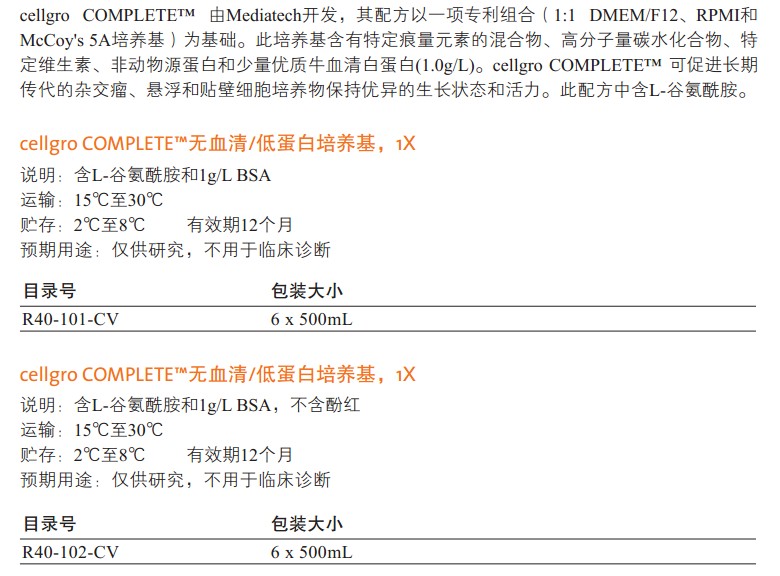
Phos-tag™ 琼脂糖
Phos-tag™ 琼脂糖
Phos-tag™ Agarose
- 产品特性
- 相关资料
- Q&A
- 参考文献
Phos-tag™ Agarose
亲和层析纯化磷酸化蛋白
填入色谱柱中使用。可分离、纯化、浓缩磷酸化蛋白。不使用界面活性剂、还原剂,可得到状态近似生物体内的磷酸化蛋白。
◆原理:
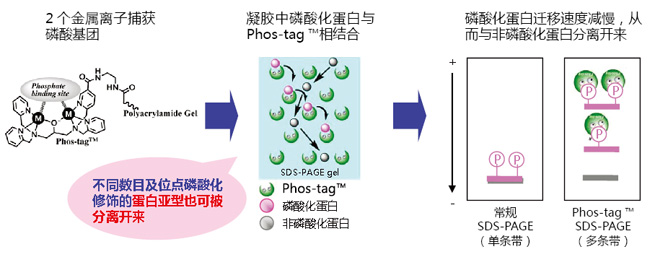
◆优点、特色:
● 缓冲液不含有界面活性剂、还原剂。
● 与亲和层析方法类似。
● 可在1小时内纯化磷酸化蛋白。
● Phos-tag™ Agarose捕获结合到Tyr、Thr、Ser、Asp、His等氨基酸、糖类、脂类上的无机磷酸根和大
量二价磷酸根。
● 可在生理条件下(pH7.5)捕捉蛋白。
● 纯化后的产物可用于Co-IP实验和其他蛋白活性实验。
◆案例、应用:
【使用例子:A431裂解液中的磷酸化蛋白的纯化】
把Phos-tag™ 填充到柱里,再加上A431 裂解液。
SYPRO Ruby染色(左图)再使用Anti-p Tyr抗体进行免疫印迹(右图),检测出结果。
结果确认磷酸化蛋白浓缩在柱吸附层里。
M:分子量标记
Lane 1:未吸附层
Lane 2:吸附层
Lane 3:柱清洗层
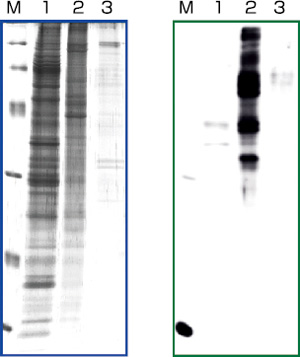
Phos-tag™ 系列
磷酸化蛋白新方法!
Phos-tag™ 是一种能与磷酸离子特异性结合的功能性分子。它可用于磷酸化蛋白的分离(Phos-tag™ Acrylamide)、Western Blot检测(Phos-tag™ Biotin)、蛋白纯化 (Phos-tag™ Agarose)及质谱分析MALDI-TOF/MS (Phos-tag™ Mass Analytical Kit)。
◆Phos-tag™ 的基本结构:
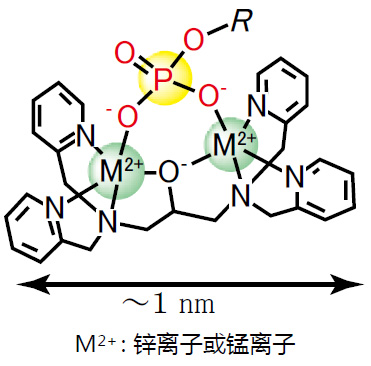
◆特点:
与-2价磷酸根离子的亲和性和选择性高于其它阴离子
在pH 5-8的生理环境下生成稳定的复合物
◆原理:
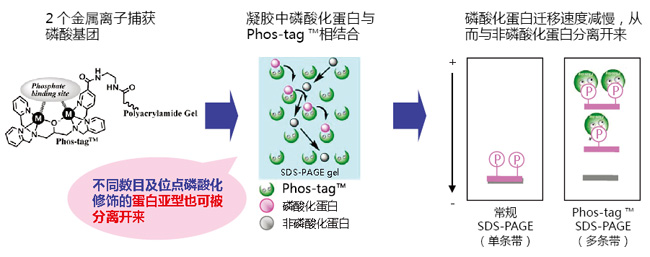
◆相关应用:
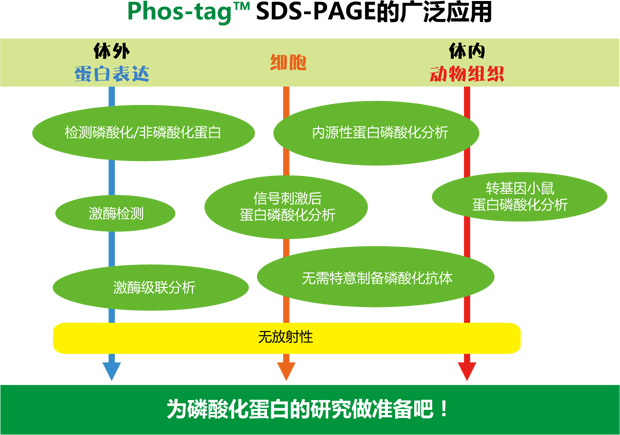
◆相关产品:
|
产品名称 |
用 途 |
|
Phos-tag™ Acrylamide |
分离: SDS – PAGE 分离不同磷酸化水平的蛋白 |
|
SuperSep Phos-tag™ |
分离: 预制胶中含有50μM Phos-tag™ Acrylamide |
|
Phos-tag™ Biotin |
检测: 代替 Western Blot 检测中的磷酸化抗体 |
|
Phos-tag™ Agarose |
纯化: 通用柱层析,纯化磷酸化蛋白 |
|
Phos-tag™ Mass Analytical Kit |
分析: 用于质谱 MALDI-TOF/MS 分析,提高磷酸化分子的检测灵敏度 |
phos-tag™ 由日本广岛大学研究生院医齿药学综合研究科医药分子功能科学研究室开发。
更多产品信息,请点击:http://phos-tag.jp
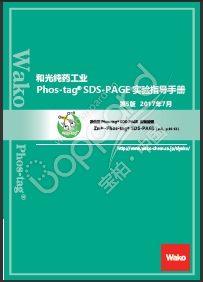
Phos-tag 第5版说明书
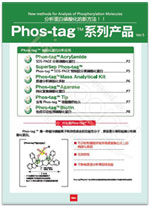
Phos-tag系列 ver 5
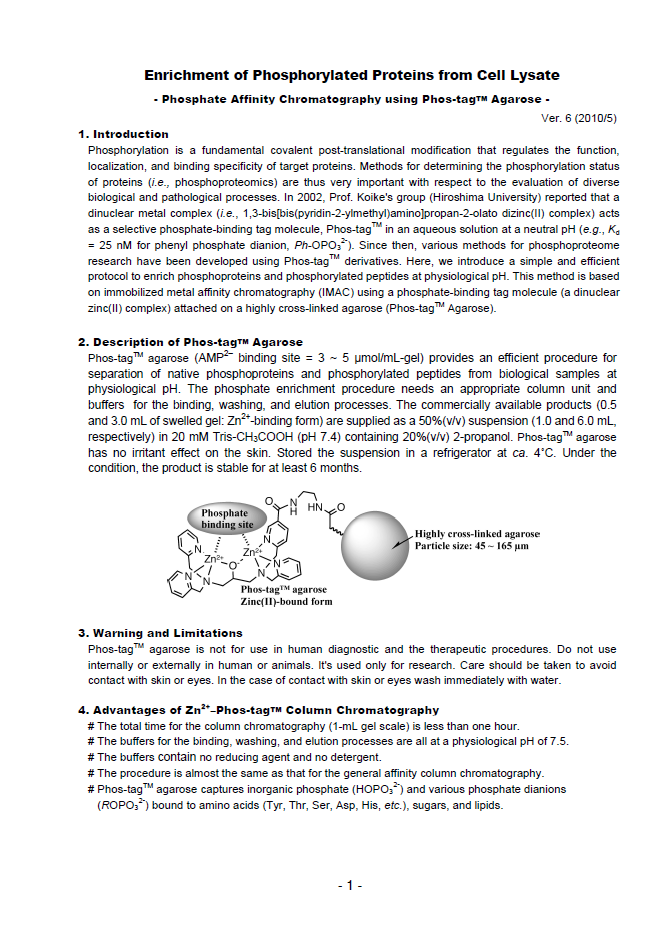
说明书
【参考文献】
· Conversion of graded phosphorylation into switch-like nuclear translocation via autoregulatory mechanisms in ERK signalling[J].Nature communications, 2016, 7,Shindo Y, Iwamoto K, Mouri K, et al.
· PTEN modulates EGFR late endocytic trafficking and degradation by dephosphorylating Rab7[J]. Nature communications, 2016, 7,Shinde S R, Maddika S.
· Feedback control of ErbB2 via ERK-mediated phosphorylation of a conserved threonine in the juxtamembrane domain[J]. Scientific Reports, 2016, 6: 31502,Kawasaki Y, Sakimura A, Park C M, et al.
· Plastid-nucleus communication involves calcium-modulated MAPK signalling[J]. Nature Communications, 2016, 7,Guo H, Feng P, Chi W, et al.
· Sequential domain assembly of ribosomal protein S3 drives 40S subunit maturation[J]. Nature communications, 2016, 7,Mitterer V, Murat G, Réty S, et al.
· Phos-tag analysis of Rab10 phosphorylation by LRRK2: a powerful assay for assessing kinase function and inhibitors[J]. Biochemical Journal, 2016: BCJ20160557,Ito G, Katsemonova K, Tonelli F, et al.
· Analysis of phosphorylation of the myosin targeting subunit of smooth muscle myosin light chain phosphatase by Phos-tag SDS-PAGE[J]. The FASEB Journal, 2016, 30(1 Supplement): 1209.1-1209.1,Walsh M P, MacDonald J A, Sutherland C.
· Using Phos-Tag in Western Blotting Analysis to Evaluate Protein Phosphorylation[J]. Kidney Research: Experimental Protocols, 2016: 267-277,Horinouchi T, Terada K, Higashi T, et al.
· The Abundance of Nonphosphorylated Tau in Mouse and Human Tauopathy Brains Revealed by the Use of Phos-Tag Method[J]. The American journal of pathology, 2016, 186(2): 398-409,Kimura T, Hatsuta H, Masuda-Suzukake M, et al.
· Phos-tag SDS-PAGE resolves agonist-and isoform-specific activation patterns for PKD2 and PKD3 in cardiomyocytes and cardiac fibroblasts[J]. Journal of Molecular and Cellular Cardiology, 2016,Qiu W, Steinberg S F.
· Analysis of phosphorylation of the myosin-targeting subunit of myosin light chain phosphatase by Phos-tag SDS-PAGE[J]. American Journal of Physiology-Cell Physiology, 2016, 310(8): C681-C691,Sutherland C, MacDonald J A, Walsh M P.
· Electrochemical biosensor for protein kinase A activity assay based on gold nanoparticles-carbon nanospheres, phos-tag-biotin and β-galactosidase[J]. Biosensors and Bioelectronics, 2016, 86: 508-515,Zhou Y, Yin H, Li X, et al.
· Validation of Cis and Trans Modes in Multistep Phosphotransfer Signaling of Bacterial Tripartite Sensor Kinases by Using Phos-Tag SDS-PAGE[J]. PloS one, 2016, 11(2): e0148294,Kinoshita-Kikuta E, Kinoshita E, Eguchi Y, et al.
· Phosphopeptide Detection with Biotin-Labeled Phos-tag[J]. Phospho-Proteomics: Methods and Protocols, 2016: 17-29,Kinoshita-Kikuta E, Kinoshita E, Koike T.
· A Phos‐tag SDS‐PAGE method that effectively uses phosphoproteomic data for profiling the phosphorylation dynamics of MEK1[J]. Proteomics, 2016,Kinoshita E, Kinoshita‐Kikuta E, Kubota Y, et al.
· Difference gel electrophoresis of phosphoproteome: U.S. Patent Application 15/004,339[P]. 2016-1-22,Tao W A, Wang L.
· ERK1/2-induced phosphorylation of R-Ras GTPases stimulates their oncogenic potential[J]. Oncogene, 2016,Frémin C, Guégan J P, Plutoni C, et al.
· Microtubules Inhibit E-Cadherin Adhesive Activity by Maintaining Phosphorylated p120-Catenin in a Colon Carcinoma Cell Model[J]. PloS one, 2016, 11(2): e0148574,Maiden S L, Petrova Y I, Gumbiner B M.
· Serine 231 and 257 of Agamous-like 15 are phosphorylated in floral receptacles[J]. Plant Signaling & Behavior, 2016, 11(7): e1199314,Patharkar O R, Macken T A, Walker J C.
· A small molecule pyrazolo [3, 4-d] pyrimidinone inhibitor of zipper-interacting protein kinase suppresses calcium sensitization of vascular smooth muscle[J]. Molecular pharmacology, 2016, 89(1): 105-117,MacDonald J A, Sutherland C, Carlson D A, et al.
· The RNA polymerase II C-terminal domain phosphatase-like protein FIERY2/CPL1 interacts with eIF4AIII and is essential for nonsense-mediated mRNA decay in Arabidopsis[J]. The Plant Cell, 2016: TPC2015-00771-RA,Chen T, Qin T, Ding F, et al.
· Vasorelaxant Effect of 5′-Methylthioadenosine Obtained from Candida utilis Yeast Extract through the Suppression of Intracellular Ca2+ Concentration in Isolated Rat Aorta[J]. Journal of agricultural and food chemistry, 2016, 64(17): 3362-3370,Kumrungsee T, Akiyama S, Saiki T, et al.
· Inhibition of deubiquitinating activity of USP14 decreases tyrosine hydroxylase phosphorylated at Ser19 in PC12D cells[J]. Biochemical and biophysical research communications, 2016, 472(4): 598-602,Nakashima A, Ohnuma S, Kodani Y, et al.
· Actin Tyrosine-53-Phosphorylation in Neuronal Maturation and Synaptic Plasticity[J]. The Journal of Neuroscience, 2016, 36(19): 5299-5313,Bertling E, Englund J, Minkeviciene R, et al.
· AMPK-dependent phosphorylation of lipid droplet protein PLIN2 triggers its degradation by CMA[J]. Autophagy, 2016, 12(2): 432-438,Kaushik S, Cuervo A M.
· Myocardin-related transcription factor a and yes-associated protein exert dual control in G protein-coupled receptor-and RhoA-mediated transcriptional regulation and cell proliferation[J]. Molecular and cellular biology, 2016, 36(1): 39-49,Olivia M Y, Miyamoto S, Brown J H.
· Extensive phosphorylation of AMPA receptors in neurons[J]. Proceedings of the National Academy of Sciences, 2016, 113(33): E4920-E4927,Diering G H, Heo S, Hussain N K, et al.
· The transmembrane region of guard cell SLAC1 channels perceives CO2 signals via an ABA-independent pathway in Arabidopsis[J]. The Plant Cell, 2016, 28(2): 557-567,Yamamoto Y, Negi J, Wang C, et al.
· The Hippo pathway mediates inhibition of vascular smooth muscle cell proliferation by cAMP[J]. Journal of molecular and cellular cardiology, 2016, 90: 1-10,Kimura T E, Duggirala A, Smith M C, et al.
· Atg13 is essential for autophagy and cardiac development in mice[J]. Molecular and cellular biology, 2016, 36(4): 585-595,Kaizuka T, Mizushima N.
· The ChrSA and HrrSA two-component systems are required for transcriptional regulation of the hemA promoter in Corynebacterium diphtheriae[J]. Journal of Bacteriology, 2016: JB. 00339-16,Burgos J M, Schmitt M P.
· Intergenic Variable-Number Tandem-Repeat Polymorphism Upstream of rocA Alters Toxin Production and Enhances Virulence in Streptococcus pyogenes[J]. Infection and Immunity, 2016, 84(7): 2086-2093,Zhu L, Olsen R J, Horstmann N, et al.
· Receptor for advanced glycation end products (RAGE) knockout reduces fetal dysmorphogenesis in murine diabetic pregnancy[J]. Reproductive Toxicology, 2016, 62: 62-70,Ejdesjö A, Brings S, Fleming T, et al.
· Aurora kinase-induced phosphorylation excludes transcription factor RUNX from the chromatin to facilitate proper mitotic progression[J]. Proceedings of the National Academy of Sciences, 2016, 113(23): 6490-6495,Chuang L S H, Khor J M, Lai S K, et al.
· Quantitative phosphoproteomics of protein kinase SnRK1 regulated protein phosphorylation in Arabidopsis under submergence[J]. Journal of experimental botany, 2016: erw107,Cho H Y, Wen T N, Wang Y T, et al.
· Temporal regulation of lipin activity diverged to account for differences in mitotic programs[J]. Current Biology, 2016, 26(2): 237-243,Makarova M, Gu Y, Chen J S, et al.
· Block of CDK1‐dependent polyadenosine elongation of Cyclin B mRNA in metaphase‐i‐arrested starfish oocytes is released by intracellular pH elevation upon spawning[J]. Molecular reproduction and development, 2016, 83(1): 79-87,Ochi H, Aoto S, Tachibana K, et al.
· Mitotic Exit Function of Polo-like Kinase Cdc5 Is Dependent on Sequential Activation by Cdk1[J]. Cell reports, 2016, 15(9): 2050-2062,Rodriguez-Rodriguez J A, Moyano Y, Játiva S, et al.
· PLK2 phosphorylates and inhibits enriched TAp73 in human osteosarcoma cells[J]. Cancer medicine, 2016, 5(1): 74-87,Hu Z B, Liao X H, Xu Z Y, et al.
· Phosphorylated TDP-43 becomes resistant to cleavage by calpain: A regulatory role for phosphorylation in TDP-43 pathology of ALS/FTLD[J]. Neuroscience research, 2016, 107: 63-69,Yamashita T, Teramoto S, Kwak S.
· The Pch2 AAA+ ATPase promotes phosphorylation of the Hop1 meiotic checkpoint adaptor in response to synaptonemal complex defects[J]. Nucleic acids research, 2016: gkw506,Herruzo E, Ontoso D, González-Arranz S, et al.
· An optimized guanidination method for large‐scale proteomic studies[J]. Proteomics, 2016,Ye J, Zhang Y, Huang L, et al.
· Expression and purification of the kinase domain of PINK1 in Pichia pastoris[J]. Protein Expression and Purification, 2016,Wu D, Qu L, Fu Y, et al.
· BRI2 and BRI3 are functionally distinct phosphoproteins[J]. Cellular signalling, 2016, 28(1): 130-144,Martins F, Rebelo S, Santos M, et al.
· Identification of glycoproteins associated with HIV latently infected cells using quantitative glycoproteomics[J]. Proteomics, 2016,Yang W, Jackson B, Zhang H.
· Regulation of Beclin 1 Protein Phosphorylation and Autophagy by Protein Phosphatase 2A (PP2A) and Death-associated Protein Kinase 3 (DAPK3)[J]. Journal of Biological Chemistry, 2016, 291(20): 10858-10866,Fujiwara N, Usui T, Ohama T, et al.
· Regulatory Implications of Structural Changes in Tyr201 of the Oxygen Sensor Protein FixL[J]. Biochemistry, 2016, 55(29): 4027-4035,Yamawaki T, Ishikawa H, Mizuno M, et al.
· Histone demethylase Jmjd3 regulates osteoblast apoptosis through targeting anti-apoptotic protein Bcl-2 and pro-apoptotic protein Bim[J]. Biochimica et Biophysica Acta (BBA)-Molecular Cell Research, 2016, 1863(4): 650-659,Yang D, Okamura H, Teramachi J, et al.
· Analysis of Molecular Species Profiles of Ceramide-1-phosphate and Sphingomyelin Using MALDI-TOF Mass Spectrometry[J]. Lipids, 2016, 51(2): 263-270,Yamashita R, Tabata Y, Iga E, et al.
· Highly sensitive myosin phosphorylation analysis in the renal afferent arteriole[J]. Journal of Smooth Muscle Research, 2016, 52(0): 45-55,Takeya K.
· Functional dissection of the CroRS two-component system required for resistance to cell wall stressors in Enterococcus faecalis[J]. Journal of bacteriology, 2016, 198(8): 1326-1336,Kellogg S L, Kristich C J.
· Regulation of mitogen-activated protein kinase by protein kinase C and mitogen-activated protein kinase phosphatase-1 in vascular smooth muscle[J]. American Journal of Physiology-Cell Physiology, 2016, 310(11): C921-C930,Trappanese D M, Sivilich S, Ets H K, et al.
· ModProt: a database for integrating laboratory and literature data about protein post-translational modifications[J]. Journal of Electrophoresis, 2016, 60(1): 1-4,Kimura Y, Toda T, Hirano H.
· The C-ETS2-TFEB Axis Promotes Neuron Survival under Oxidative Stress by Regulating Lysosome Activity[J]. Oxidative medicine and cellular longevity, 2016,Ma S, Fang Z, Luo W, et al.
· Essential role of the PSI–LHCII supercomplex in photosystem acclimation to light and/or heat conditions by state transitions[J]. Photosynthesis Research, 2016: 1-10,Marutani Y, Yamauchi Y, Higashiyama M, et al.
· Identification of a redox-modulatory interaction between selenoprotein W and 14-3-3 protein[J]. Biochimica et Biophysica Acta (BBA)-Molecular Cell Research, 2016, 1863(1): 10-18,Jeon Y H, Ko K Y, Lee J H, et al.
· Effects of hydrogen sulfide on the heme coordination structure and catalytic activity of the globin-coupled oxygen sensor AfGcHK[J]. BioMetals, 2016, 29(4): 715-729,Fojtikova V, Bartosova M, Man P, et al.
· Identification and functional analysis of phosphorylation in Newcastle disease virus phosphoprotein[J]. Archives of virology, 2016: 1-14,Qiu X, Zhan Y, Meng C, et al.
· Increased level of phosphorylated desmin and its degradation products in heart failure[J]. Biochemistry and Biophysics Reports, 2016, 6: 54-62,Bouvet M, Dubois-Deruy E, Alayi T D, et al.
· Profiling DNA damage-induced phosphorylation in budding yeast reveals diverse signaling networks[J]. Proceedings of the National Academy of Sciences, 2016: 201602827,Zhou C, Elia A E H, Naylor M L, et al.
· Unexpected properties of sRNA promoters allow feedback control via regulation of a two-component system[J]. Nucleic Acids Research, 2016: gkw642,Brosse A, Korobeinikova A, Gottesman S, et al.
· Evolution of ZnII–Macrocyclic Polyamines to Biological Probes and Supramolecular Assembly[J]. Macrocyclic and Supramolecular Chemistry: How Izatt-Christensen Award Winners Shaped the Field, 2016: 415,Kimura E, Koike T, Aoki S.
· Phosphopeptide Enrichment Using Various Magnetic Nanocomposites: An Overview[J]. Phospho-Proteomics: Methods and Protocols, 2016: 193-209,Batalha Í L, Roque A C A.
· In vivo phosphorylation of a peptide tag for protein purification[J]. Biotechnology letters, 2016, 38(5): 767-772,Goux M, Fateh A, Defontaine A, et al.
· Regulation of cell reversal frequency in Myxococcus xanthus requires the balanced activity of CheY‐like domains in FrzE and FrzZ[J]. Molecular microbiology, 2016,Kaimer C, Zusman D R.
· Elevation of cortical serotonin transporter activity upon peripheral immune challenge is regulated independently of p38 mitogen‐activated protein kinase activation and transporter phosphorylation[J]. Journal of neurochemistry, 2016, 137(3): 423-435,Schwamborn R, Brown E, Haase J.
· The Yeast Cyclin-Dependent Kinase Routes Carbon Fluxes to Fuel Cell Cycle Progression[J]. Molecular cell, 2016, 62(4): 532-545,Ewald J C, Kuehne A, Zamboni N, et al.
· Two Degradation Pathways of the p35 Cdk5 (Cyclin-dependent Kinase) Activation Subunit, Dependent and Independent of Ubiquitination[J]. Journal of Biological Chemistry, 2016, 291(9): 4649-4657,Takasugi T, Minegishi S, Asada A, et al.
· Increased level of phosphorylated desmin and its degradation products in heart failure[J]. Biochemistry and Biophysics Reports. 2016,Bouvet M, Dubois-Deruy E, Alayi T D, et al.
· a high‐affinity LCO‐binding protein of Medicago truncatula, interacts with LYK3, a key symbiotic receptor[J]. FEBS letters, 2016, 590(10): 1477-1487,Fliegmann J, Jauneau A, Pichereaux C, et al. LYR3,
· Nek1 Regulates Rad54 to Orchestrate Homologous Recombination and Replication Fork Stability[J]. Molecular Cell, 2016,Spies J, Waizenegger A, Barton O, et al.
· PhostagTM-gel retardation and in situ thylakoid kinase assay for determination of chloroplast protein phosphorylation targets[J]. Endocytobiosis and Cell Research, 2016, 27(2): 62-70,Dytyuk Y, Flügge F, Czarnecki O, et al.
· Luteinizing Hormone Causes Phosphorylation and Activation of the cGMP Phosphodiesterase PDE5 in Rat Ovarian Follicles, Contributing, Together with PDE1 Activity, to the Resumption of Meiosis[J]. Biology of reproduction, 2016: biolreprod. 115.135897,Egbert J R, Uliasz T F, Shuhaibar L C, et al.
· Newby, AC, & Bond, M.(2016). The Hippo pathway mediates inhibition of vascular smooth muscle cell proliferation by cAMP[J]. Journal of Molecular and Cellular Cardiology, 2016, 90: 1-10,Kimura-Wozniak T, Duggirala A, Smith M C, et al. G.
· Yeast lacking the amphiphysin family protein Rvs167 is sensitive to disruptions in sphingolipid levels[J]. The FEBS Journal, 2016, 283(15): 2911-2928,Toume M, Tani M.
· Regulation of CsrB/C sRNA decay by EIIAGlc of the phosphoenolpyruvate: carbohydrate phosphotransferase system[J]. Molecular microbiology, 2016, 99(4): 627-639,Leng Y, Vakulskas C A, Zere T R, et al.
· The Late S-Phase Transcription Factor Hcm1 Is Regulated through Phosphorylation by the Cell Wall Integrity Checkpoint[J]. Molecular and cellular biology, 2016: MCB. 00952-15,Negishi T, Veis J, Hollenstein D, et al.
· Validation of chemical compound library screening for transcriptional co‐activator with PDZ‐binding motif inhibitors using GFP‐fused transcriptional co‐activator with PDZ‐binding motif[J]. Cancer science, 2016, 107(6): 791-802,Nagashima S, Maruyama J, Kawano S, et al.
· ULK1/2 Constitute a Bifurcate Node Controlling Glucose Metabolic Fluxes in Addition to Autophagy[J]. Molecular cell, 2016, 62(3): 359-370,Li T Y, Sun Y, Liang Y, et al.
· Spatiotemporal dynamics of Oct4 protein localization during preimplantation development in mice[J]. Reproduction, 2016: REP-16-0277,Fukuda A, Mitani A, Miyashita T, et al.
· The tandemly repeated NTPase (NTPDase) from Neospora caninum is a canonical dense granule protein whose RNA expression, protein secretion and phosphorylation coincides with the tachyzoite egress[J]. Parasites & Vectors, 2016, 9(1): 1,Pastor-Fernández I, Regidor-Cerrillo J, Álvarez-García G, et al.
· Interaction Analysis of a Two-Component System Using Nanodiscs[J]. PloS one, 2016, 11(2): e0149187,Hörnschemeyer P, Liss V, Heermann R, et al.
· Constitutive Activation of PINK1 Protein Leads to Proteasome-mediated and Non-apoptotic Cell Death Independently of Mitochondrial Autophagy[J]. Journal of Biological Chemistry, 2016, 291(31): 16162-16174,Akabane S, Matsuzaki K, Yamashita S, et al.
· p38β Mitogen-Activated Protein Kinase Modulates Its Own Basal Activity by Autophosphorylation of the Activating Residue Thr180 and the Inhibitory Residues Thr241 and Ser261[J]. Molecular and cellular biology, 2016, 36(10): 1540-1554,Beenstock J, Melamed D, Mooshayef N, et al.
· Lysophosphatidylcholine acyltransferase 1 protects against cytotoxicity induced by polyunsaturated fatty acids[J]. The FASEB Journal, 2016, 30(5): 2027-2039,Akagi S, Kono N, Ariyama H, et al.
· Characterization of a herpes simplex virus 1 (HSV-1) chimera in which the Us3 protein kinase gene is replaced with the HSV-2 Us3 gene[J]. Journal of virology, 2016, 90(1): 457-473,Shindo K, Kato A, Koyanagi N, et al.
· Generation of phospho‐ubiquitin variants by orthogonal translation reveals codon skipping[J]. FEBS letters, 2016, 590(10): 1530-1542,George S, Aguirre J D, Spratt D E, et al.
· Evolution of KaiC-Dependent Timekeepers: A Proto-circadian Timing Mechanism Confers Adaptive Fitness in the Purple Bacterium Rhodopseudomonas palustris[J]. PLoS Genet, 2016, 12(3): e1005922,Ma P, Mori T, Zhao C, et al.
· Phosphorylation of Bni4 by MAP kinases contributes to septum assembly during yeast cytokinesis[J]. FEMS Yeast Research, 2016, 16(6): fow060,Pérez J, Arcones I, Gómez A, et al.
· Alteration of Antiviral Signalling by Single Nucleotide Polymorphisms (SNPs) of Mitochondrial Antiviral Signalling Protein (MAVS)[J]. PloS one, 2016, 11(3): e0151173,Xing F, Matsumiya T, Hayakari R, et al.
· Arm-in-arm response regulator dimers promote intermolecular signal transduction[J]. Journal of bacteriology, 2016, 198(8): 1218-1229,Baker A W, Satyshur K A, Morales N M, et al.
· The lsh/ddm1 homolog mus-30 is required for genome stability, but not for dna methylation in neurospora crassa[J]. PLoS Genet, 2016, 12(1): e1005790,Basenko E Y, Kamei M, Ji L, et al.
· Fine tuning chloroplast movements through physical interactions between phototropins[J]. Journal of Experimental Botany, 2016: erw265,Sztatelman O, Łabuz J, Hermanowicz P, et al.
· Characterization of the Neospora caninum NcROP40 and NcROP2Fam-1 rhoptry proteins during the tachyzoite lytic cycle[J]. Parasitology, 2016, 143(01): 97-113,Pastor-Fernandez I, Regidor-Cerrillo J, Jimenez-Ruiz E, et al.
· Transcriptional Profile during Deoxycholate-Induced Sporulation in a Clostridium perfringens Isolate Causing Foodborne Illness[J]. Applied and environmental microbiology, 2016, 82(10): 2929-2942,Yasugi M, Okuzaki D, Kuwana R, et al.
· Timely Closure of the Prospore Membrane Requires SPS1 and SPO77 in Saccharomyces cerevisiae[J]. Genetics, 2016: genetics. 115.183939,Paulissen S M, Slubowski C J, Roesner J M, et al.
· DDK dependent regulation of TOP2A at centromeres revealed by a chemical genetics approach[J]. Nucleic Acids Research, 2016: gkw626,Wu K Z L, Wang G N, Fitzgerald J, et al.
· OVATE Family Protein 8 Positively Mediates Brassinosteroid Signaling through Interacting with the GSK3-like Kinase in Rice[J]. PLoS Genet, 2016, 12(6): e1006118,Yang C, Shen W, He Y, et al.
· Epithelial Sel1L is required for the maintenance of intestinal homeostasis[J]. Molecular biology of the cell, 2016, 27(3): 483-490, Sun S, Lourie R, Cohen S B, et al.
· Effect of Sodium Dodecyl Sulfate Concentration on Supramolecular Gel Electrophoresis[J]. ChemNanoMat, 2016,Tazawa S, Kobayashi K, Yamanaka M.
· Intergenic VNTR Polymorphism Upstream of rocA Alters Toxin Production and Enhances Virulence in Streptococcus pyogenes[J]. Infection and immunity, 2016: IAI. 00258-16,Zhu L, Olsen R J, Horstmann N, et al.
· Ajuba Phosphorylation by CDK1 Promotes Cell Proliferation and Tumorigenesis[J]. Journal of Biological Chemistry, 2016: jbc. M116. 722751,Chen X, Stauffer S, Chen Y, et al.
· Editorial: International Plant Proteomics Organization (INPPO) World Congress 2014[J]. Frontiers in Plant Science, 2016, 7,Heazlewood J L, Jorrín-Novo J V, Agrawal G K, et al.
· Phosphoinositide kinase signaling controls ER-PM cross-talk[J]. Molecular biology of the cell, 2016, 27(7): 1170-1180,Omnus D J, Manford A G, Bader J M, et al.
· A multiple covalent crosslinked soft hydrogel for bioseparation[J]. Chemical Communications, 2016, 52(15): 3247-3250,Liu Z, Fan L, Xiao H, et al.
· Advances in crop proteomics: PTMs of proteins under abiotic stress[J]. Proteomics, 2016, 16(5): 847-865,Wu X, Gong F, Cao D, et al.
· Cyclin-Dependent Kinase Co-Ordinates Carbohydrate Metabolism and Cell Cycle in S. cerevisiae[J]. Molecular cell, 2016, 62(4): 546-557,Zhao G, Chen Y, Carey L, et al.
· Carbon Monoxide Gas Is Not Inert, but Global, in Its Consequences for Bacterial Gene Expression, Iron Acquisition, and Antibiotic Resistance[J]. Antioxidants & redox signaling, 2016,Wareham L K, Begg R, Jesse H E, et al.
· Two-layer regulation of PAQR3 on ATG14-linked class III PtdIns3K activation upon glucose starvation[J]. Autophagy, 2016: 1-2,Xu D, Wang Z, Chen Y.
· Regulation of sphingolipid biosynthesis by the morphogenesis checkpoint kinase Swe1[J]. Journal of Biological Chemistry, 2016, 291(5): 2524-2534,Chauhan N, Han G, Somashekarappa N, et al.
· PAX5 tyrosine phosphorylation by SYK co-operatively functions with its serine phosphorylation to cancel the PAX5-dependent repression of BLIMP1: A mechanism for antigen-triggered plasma cell differentiation[J]. Biochemical and biophysical research communications, 2016, 475(2): 176-181,Inagaki Y, Hayakawa F, Hirano D, et al.
· A Combined Computational and Genetic Approach Uncovers Network Interactions of the Cyanobacterial Circadian Clock[J]. Journal of Bacteriology, 2016: JB. 00235-16,Boyd J S, Cheng R R, Paddock M L, et al.
· HuR mediates motility of human bone marrow-derived mesenchymal stem cells triggered by sphingosine 1-phosphate in liver fibrosis[J]. Journal of Molecular Medicine, 2016: 1-14,Chang N, Ge J, Xiu L, et al.
· Combined replacement effects of human modified β-hexosaminidase B and GM2 activator protein on GM2 gangliosidoses fibroblasts[J]. Biochemistry and Biophysics Reports, 2016,Kitakaze K, Tasaki C, Tajima Y, et al.
· Roseotoxin B Improves Allergic Contact Dermatitis through a Unique Anti-inflammatory Mechanism Involving Excessive Activation of Autophagy in Activated T-Lymphocytes[J]. Journal of Investigative Dermatology, 2016,Wang X, Hu C, Wu X, et al.
References on Phos-tag™ Chemistry
Matrix-assisted laser desorption/ionization time-of-flight mass spectrometry of phosphorylated compounds using a novel phosphate capture molecule, Rapid Communications of Mass Spectrometry, 17, 2075-2081 (2003), H. Takeda, A. Kawasaki, M. Takahashi, A. Yamada, and T. Koike
Recognition of phosphate monoester dianion by an alkoxide-bridged dinuclear zinc (II) complex, Dalton Transactions, 1189-1193 (2004), E. Kinoshita, M. Takahashi, H. Takeda, M. Shiro, and T. Koike
Quantitative analysis of lysophosphatidic acid by time-of-flight mass spectrometry using a phosphate capture molecule, Journal of Lipid Research, 45, 2145-2150 (2004), T. Tanaka, H. Tsutsui, K. Hirano, T. Koike, A. Tokumura, and K. Satouchi
Production of 1,2-Didocosahexaenoyl Phosphatidylcholine by Bonito Muscle Lysophosphatidylcholine/Transacylase, Journal of Biochemistry,136, 477-483 (2004), K. Hirano, H. Matsui, T. Tanaka, F. Matsuura, K. Satouchi, and T. Koike
Novel immobilized zinc(II) affinity chromatography for phosphopeptides and phosphorylated proteins, Journal of Separation Science, 28, 155-162 (2005), E. Kinoshita, A. Yamada, H. Takeda, E. Kinoshita-Kikuta, and T. Koike
Detection and Quantification of On-Chip Phosphorylated Peptides by Surface Plasmon Resonance Imaging Techniques Using a Phosphate Capture Molecule, Analytical Chemistry, 77, 3979-3985 (2005), K. Inamori, M. Kyo, Y. Nishiya, Y. Inoue, T. Sonoda, E. Kinoshita, T. Koike, and Y. Katayama
Phosphate-binding tag: A new tool to visualize phosphorylated proteins, Molecular & Cellular Proteomics, 5, 749-757 (2006), E. Kinoshita, E. Kinoshita-Kikuta, K. Takiyama, and T. Koike
Enrichment of phosphorylated proteins from cell lysate using phosphate-affinity chromatography at physiological pH, Proteomics, 6, 5088-5095 (2006), E. Kinoshita-Kikuta, E. Kinoshita, A. Yamada, M. Endo, and T. Koike
Separation of a phosphorylated histidine protein using phosphate affinity polyacrylamide gel electrophoresis, Analytical Biochemistry, 360, 160-162 (2007), S. Yamada, H. Nakamura, E. Kinoshita, E. Kinoshita-Kikuta, T. Koike, and Y. Shiro
Label-free kinase profiling using phosphate-affinity polyacrylamide gel electrophresis, Molecular & Cellular Proteomics, 6, 356-366 (2007), E. Kinoshita-Kikuta, Y. Aoki, E. Kinoshita, and T. Koike
A SNP genotyping method using phosphate-affinity polyacrylamide gel electrophoresis, Analytical Biochemistry, 361, 294-298 (2007), E. Kinoshita, E. Kinoshita-Kikuta, and T. Koike (The phosphate group at DNA-terminal is efficiently captured by Zn2+.Phos-tag.)
Identification on Membrane and Characterization of Phosphoproteins Using an Alkoxide-Bridged Dinuclear Metal Complex as a Phosphate-Binding Tag Molecule, Journal of Biomolecular Techniques, 18, 278-286 (2007), T. Nakanishi, E. Ando, M. Furuta, E. Kinoshita, E. Kikuta-Kinoshita, T. Koike, S. Tsunasawa, and O. Nishimura
A mobility shift detection method for DNA methylation analysis using phosphate affinity polyacrylamide gel electrophoresis, Analytical Biochemistry, 378, 102-104 (2008), E. Kinoshita-Kikuta, E. Kinoshita, and T. Koike
Separation of phosphoprotein isotypes having the same number of phosphate groups using phosphate- affinity SDS-PAGE, Proteomics, 8, 2994-3003 (2008), E. Kinoshita, E. Kinoshita-Kikuta, M. Matsubara, S. Yamada, H. Nakamura, Y. Shiro, Y. Aoki, K. Okita, and T. Koike
FANCI phosphorylation functions as a molecular switch to turn on the Fanconi anemia pathway, Nature Structural & Molecular Biology, 15, 1138-1146 (2008), M. Ishiai, H. Kitao, A. Smogorzewska, J. Tomida, A. Kinomura, E. Uchida, A. Saberi, E. Kinoshita, E. Kinoshita-Kikuta, T. Koike, S. Tashiro, S. J. Elledge, and M. Takata
Two-dimensional phosphate affinity gel electrophoresis for the analysis of phosphoprotein isotypes , Electrophoresis, 30, 550-559 (2009), E. Kinoshita, E. Kinoshita-Kikuta, M. Matsubara, Y. Aoki, S. Ohie, Y. Mouri, and T. Koike
Formation of lysophosphatidic acid, a wound-healing lipid, during digestion of cabbage leaves, Bioscience, Biotechnology, and Biochemistry,73, 1293-300 (2009), T. Tanaka, G. Horiuchi, M. Matsuoka, K. Hirano, A. Tokumura, T. Koike, and K. Satouchi
A Phos-tag-based fluorescence resonance energy transfer system for the analysis of the dephosphorylation of phosphopeptides, Analytical Biochemistry, 388, 235-241, (2009), K. Takiyama, E. Kinoshita, E. Kinoshita-Kikuta, Y. Fujioka, Y. Kubo, and T. Koike
Phos-tag beads as an immunoblotting enhancer for selective detection of phosphoproteins in cell lysates, Analytical Biochemistry, 389, 83-85, (2009), E. Kinoshita-Kikuta, E. Kinoshita, and T. Koike
Mobility shift detection of phosphorylation on large proteins using a Phos-tag SDS-PAGE gel strengthened with agarose, Proteomics, 9, 4098- 4101 (2009), E. Kinoshita, E. Kinoshita-Kikuta, H. Ujihara, and T. Koike
Separation and detection of large phosphoproteins using Phos-tag SDS-PAGE, Nature Protocols, 4, 1513-1521 (2009), E. Kinoshita, E. Kinoshita-Kikuta, and T. Koike
A clean-up technology for the simultaneous determination of lysophosphatidic acid and sphingosine-1-phosphate by matrix-assisted laser desorption/ionization time-of-flight mass spectrometry using a phosphate-capture molecule, Phos-tag, Rapid Communications in Mass Spectrometry, 24, 1075-1084 (2010), J. Morishige, M. Urikura, H. Takagi, K. Hirano, T. Koike, T. Tanaka, and K. Satouchi
Genotyping and mapping assay of single-nucleotide polymorphisms in CYP3A5 using DNA-binding zinc(II) complexes, Clinical Biochemistry, 43, 302-306 (2010), E. Kinoshita, E. Kinoshita-Kikuta, H. Nakashima, and T. Koike
The DNA-binding activity of mouse DNA methyltransferase 1 is ragulated phosphorylation with casein kinase 1σ/ε, Biochemical Journal, 427, 489-497 (2010), Y. Sugiyama, N. Hatano, N. Sueyoshi, I. Suetake, S. Tajima, E. Kinoshita, E. Kinoshita-Kikuta, T. Koike, and I. Kameshita
| 产品编号 | 产品名称 | 产品规格 | 产品等级 | 产品价格 |
| 308-93563 | P™ Agarose Phos-tag 琼脂糖 |
3ml | – | – |
德国艾本德0.5-10µl多道可调移液器整支灭菌0.5-10µl
德国艾本德0.5-10µl多道可调移液器整支灭菌
简要描述:德国艾本德0.5-10µl多道可调移液器整支灭菌Research plus>移液器符合人体工程学设计,重量轻,且操作用力小,可以有效防止手部重复性劳损(RSI)。其前端的吸嘴具有伸缩性,不但可使安装和脱卸吸头更加省力,还能保证吸头和移液器之间的气密性。尤其对于多道移液器,可以保证吸头位置*,确保移液*性。
产品型号: 0.5-10µl
所属分类:移液器
| 品牌 | eppendorf/德国艾本德 | 自动程度 | 手动移液器 |
|---|---|---|---|
| 价格区间 | 4千-8千 | 仪器种类 | 多道移液器 |
| 产地类别 | 进口 | 应用领域 | 医疗卫生,环保,化工,生物产业 |
产品概况:
从1961年推出较早支工业化的气体活塞式移液器至今,Eppendorf公司秉承近50年的生产经验和坚持高品质的执着,不断创新研发,旨在为科研临床用户提供较*的移液器。
德国艾本德0.5-10µl多道可调移液器整支灭菌
Research plus>移液器符合人体工程学设计,重量轻,且操作用力小,可以有效防止手部重复性劳损(RSI)。其前端的吸嘴具有伸缩性,不但可使安装和脱卸吸头更加省力,还能保证吸头和移液器之间的气密性。尤其对于多道移液器,可以保证吸头位置*,确保移液*性。
Research plus移液器采用高科技材质,耐化学腐蚀、抗高温,同时,可以整支高温高压灭菌和紫外灭菌。*的密度调节功能,可使Research plus移取与水密度不*的液体。移液器的拆卸和维护也非常便捷。多道移液器可手动调节满足不同耗材的孔距。
终于,Research plus移液器诞生,为现今移液行业建立了至高标准。全新Research plus移液器采用高科技材质结合先进的生产工艺流程,其设计理念符合人体工程学,加上人性化的操作应用,不但精准性高、经久耐用,同时适用于各类实验操作。
德国艾本德0.5-10µl多道可调移液器整支灭菌
产品特征:
采用PerfectPiston™系统的高科技材质,坚固耐用,耐高温抗腐蚀
可整支高温高压灭菌和紫外线灭菌,操作更安全
四位数字体积显示,位置合理,便于移液时观察
人体工程学设计,重量轻,显著减少操作用力,避免发生手部重复性劳损(RSI)
伸缩式弹性吸嘴设计,防止吸头安装高高低低,确保移液气密性和均一性
Eppendorf 密度调节功能,适用于不同密度的液体,通用性更广泛
单独活塞设计,每个通道可单独拆卸,便于维护和清洁
通道数字标识,确保同一方向移液
有关移液器问题和信息可以致电:
德国艾本德Eppendorf Research® plus 多道可调移液器
技术参数:
|
量程 |
体积 |
系统误差 |
随机误差 |
||
|
灰色控制按钮,适配 20 μl 吸头 |
|||||
|
0.5–10 μl |
0,5 μl |
±12,0% |
±0,06 μl |
±8,0% |
±0,04 μl |
|
|
1 μl |
±8,0% |
±0,08 μl |
±5,0% |
±0,05 μl |
|
|
5 μl |
±4,0% |
±0,2 μl |
±2,0% |
±0,1 μl |
|
|
10 μl |
±2,0% |
±0,2 μl |
±1,0% |
±0,1 μl |
|
黄色控制按钮,适配 200 μl 吸头 |
|||||
|
10–100 μl |
10 μl |
±3,0% |
±0,3 μl |
±2,0% |
±0,2 μl |
|
|
50 μl |
±1,0% |
±0,5 μl |
±0,8% |
±0,4 μl |
|
|
100 μl |
±0,8% |
±0,8 μl |
±0,3% |
±0,3 μl |
|
桔黄色控制按钮,适配 300 μl 吸头 |
|||||
|
30–300 μl |
30 μl |
±3,0% |
±0,9 μl |
±1,0% |
±0,3 μl |
|
|
150 μl |
±1,0% |
±1,5 μl |
±0,5% |
±0,75 μl |
|
|
300 μl |
±0,6% |
±1,8 μl |
±0,3% |
±0,9 μl |
德国艾本德Eppendorf Research® plus 多道可调移液器
订货信息:
|
量程 |
8道移液器 |
12道移液器 |
|
0.5–10 μl 灰色控制按钮,适配10 μl吸头 |
3122 000.019 |
3122 000.027 |
|
10–100 μl黄色控制按钮,适配200 μl 吸头 |
3122 000.035 |
3122 000.043 |
|
30–300 μl桔黄色控制按钮,适配300 μl 吸头 |
3122 000.051 |
3122 000.060 |
GE Whatman沃特曼2122称量纸10347893
GE Whatman沃特曼2122称量纸
简要描述:
GE Whatman沃特曼2122称量纸,无残留溶解于溶液中,不会影响分析结果,由极低含氮量的羊皮纸制成,不含任何黏合剂或添加剂。
GE Whatman沃特曼2122称量纸 10347893
凯氏(测定氮)法称量船
特性
•在安全、可靠的称量、转移凯氏样品方面表现zhuo越
•无残留溶解于溶液中,不会影响分析结果
•由极低含氮量的羊皮纸制成,不含任何黏合剂或添加剂
可将样品连称量船一起放入凯氏瓶/消化管中的酸性溶液里避免样品损失,溶解的残渣不会影响检测结果。是转移凯氏定氮法样品z为快速、安全和值得信赖的方法。
羊皮纸
特性
•透明和光滑
•可用于各种样品的称重
•定量转移
GE Whatman沃特曼2122称量纸 10347893
订货信息:



